South Carolina Highway Patrol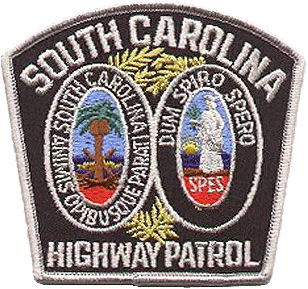
South Carolina Highway Patrol
As with most jurisdictions in the United States in the 1920's and 1930's, lack of motor vehicle driver control and law enforcement prompted legislators in the Palmetto State to devise a plan and an agency to effectively administer and oversee the upholding of laws governing motor vehicles and the rules of the road.
In 1930, the Driver Licensing Act was passed and the new South Carolina Highway Patrol was formed. 69 men were selected to patrol almost 6000 miles of highway in the state at that time. Unlike most early state law enforcement agencies of the day, these original members of the SCHP had no formalized training.
They were simply issued a gun, a badge and a uniform and with a few verbal instructions, were told to hit the road and start enforcing the law. The authority vested upon these new officers were parallel to the powers of county sheriffs where it pertained to highway traffic law, and were responsible for enforcement of the new licensing law and promoting highway safety.
Formalized training commenced in 1932 at Camp Jackson where recruits underwent three months of training in all phases of patrol work. In 1937, the Highway Safety Act prompted the SCHP to grow to 90 members with 79 being patrol officers. At this time, patrol cars began to replace motorcycles as the primary means of patrol transportation.
Motorcycles did make a comeback to the SCHP after a 50 year hiatus. Recently, the SCHP motorcycle fleet has consisted of six Harley Davidson FLHPT models and eleven BMW RT1100 models.
Radar use was introduced in 1962 for speed enforcement and unmarked patrol cars commenced duty on the highways of South Carolina in 1965. In 1978, SCHP patrol vehicles went to metallic silver and blue stripes for the first time. In the 1980's, the SCHP experimented with 5 Liter Ford Mustangs for patrol, but by 1994, they were phased-out in favor of unmarked Crown Victorias.
That same year, all seven patrol districts were issued semi-marked Ford Explorers as an Emergency Preparedness and Special Enforcement Vehicle. The following year saw the introduction of the Chevy Camaro to the SCHP fleet. Due to state government restructuring, the SCHP became part of the Department of Public Safety in 1993.
The mission of the SCHP is to provide equitable service and protection and to uphold the laws and constitutions of the United States and the State of South Carolina in order to promote a safe and secure environment for the public.
The earliest use of license plates on the cars of the SCHP indicated R-prefixed plates as early as 1931. The license plates issued that year for state government vehicles were painted green over gray and measured 13 1/4" X 5 1/2". The formatting for these plates was R-#-### over S.C.-THE IODINE STATE-31. Confirmed SCHP numbers for that year are: R-4-162, R-4-215 and R-4-864.
By the 1940's, the SCHP continued with regular passenger car license plates denoted by a letter prefix indicating the car's weight class. C prefix plates were for cars weighing 2501 to 3000 pounds. D prefix plates were for cars weighing 3001 to 3500 pounds and E prefix plates were for cars weighing 3501 to 4000 pounds. The predominant prefix seen on SCHP cars in the 1940's through early 1950's was D until the late 1950's-1960's when E prefixes were more prevalent with the "chrome age".
A great deal of thanks goes to Ben Bunton of scplates.com for providing some of the photos of the earlier South Carolina passenger license plates seen below.
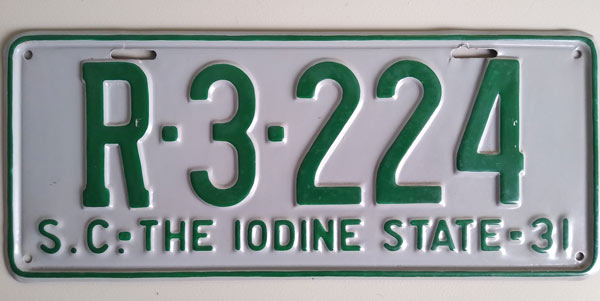 1931 State Government issue.
1931 State Government issue. 
 The Fleet- 1936
The Fleet- 1936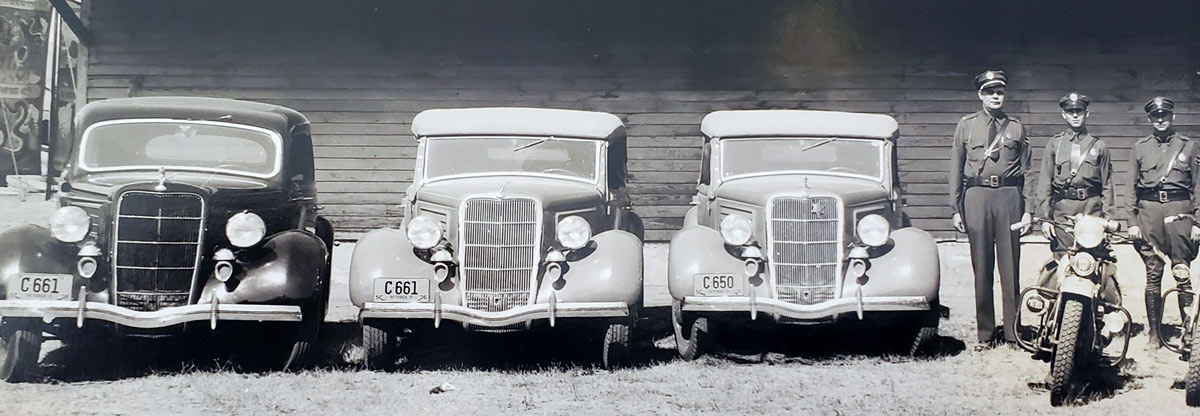 SCHP cars displaying 1936 Weight Class C (2501-3000 lbs) Passenger plates.
SCHP cars displaying 1936 Weight Class C (2501-3000 lbs) Passenger plates. 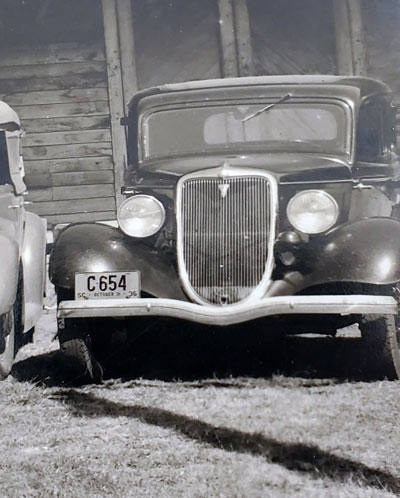 1936 Weight Class C (2501-3000 lbs) Passenger plates.
1936 Weight Class C (2501-3000 lbs) Passenger plates. 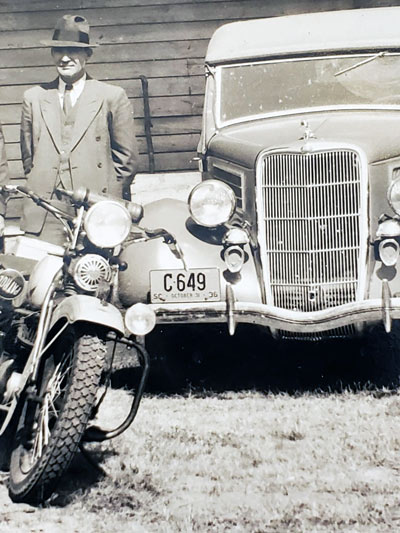 1936 Weight Class C (2501-3000 lbs) Passenger plates.
1936 Weight Class C (2501-3000 lbs) Passenger plates. 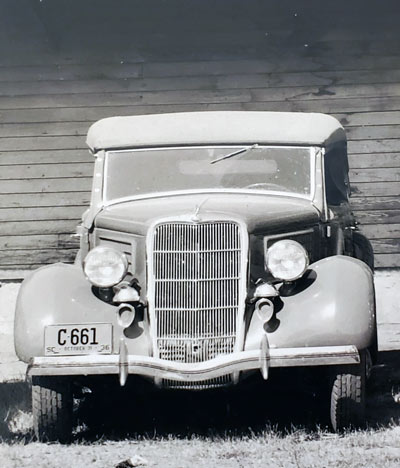 1936 Weight Class C (2501-3000 lbs) Passenger plates.
1936 Weight Class C (2501-3000 lbs) Passenger plates. 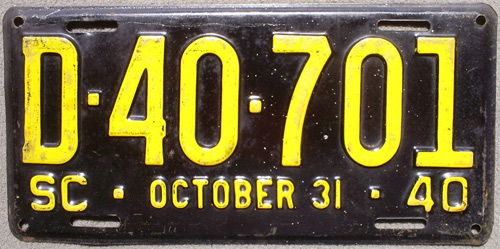 1940- Weight Class D 1940- Weight Class D(3001-3500 lbs) Passenger plates. Approx. 6" x 12 1/2". Embossed steel. Deep yellow over black. |
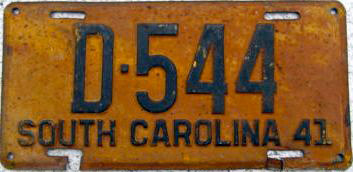 1941-Weight Class D 1941-Weight Class D (3001-3500 lbs) Passenger plates. Approx. 6" x 12 1/2". Embossed steel. Black over deep yellow. |
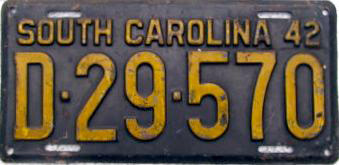 1942-Weight Class D 1942-Weight Class D (3001-3500 lbs) Passenger plates. Approx. 6" x 12 1/2". Embossed steel. Deep yellow over black. |
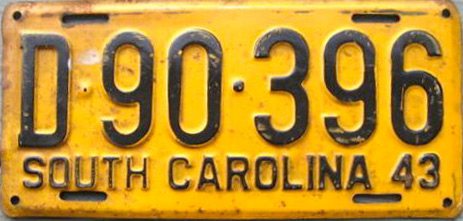 1943-
Weight Class D 1943-
Weight Class D (3001-3500 lbs) Passenger plates. Approx. 6" x 12 1/2". Embossed steel. Black over deep yellow. |
 1944-tab strip used on 1943 plate. 1944-tab strip used on 1943 plate.Vehicle weight class letter prefix. Approx. 1 3/4" x 11". Embossed steel. Deep yellow over dark green. |
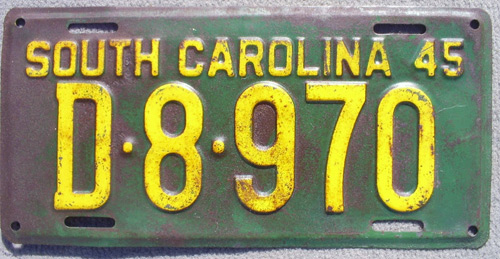 1945-Weight Class D 1945-Weight Class D (3001-3500 lbs) Passenger plates. Approx. 6" x 12 1/2". Embossed steel. Deep yellow over green. |
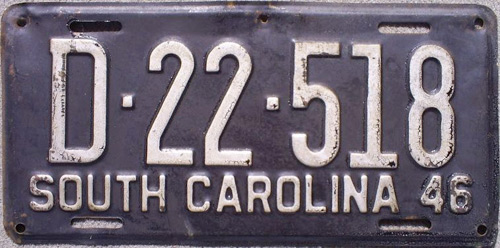 1946-Weight Class D 1946-Weight Class D (3001-3500 lbs) Passenger plates. Approx. 6" x 12 1/2". Embossed steel. White over black. |
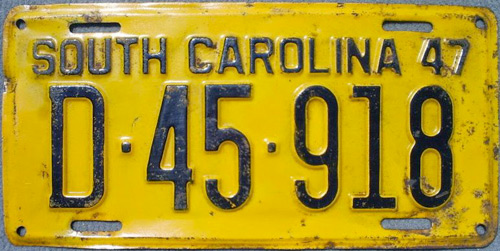 1947-Weight Class D 1947-Weight Class D (3001-3500 lbs) Passenger plates. Approx. 6" x 12 1/2". Embossed steel. Black over deep yellow. |
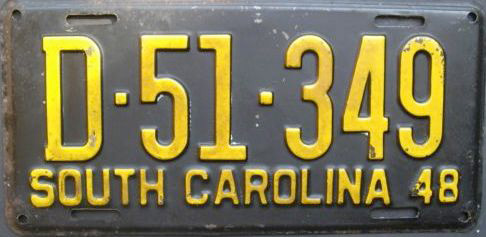 1948-Weight Class D 1948-Weight Class D (3001-3500 lbs) Passenger plates. Approx. 6" x 12 1/2". Embossed steel. Deep yellow over black. |
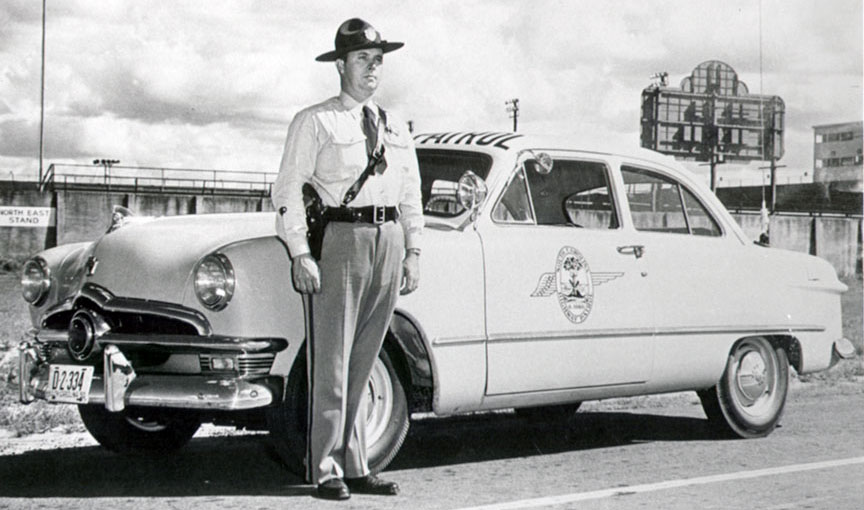
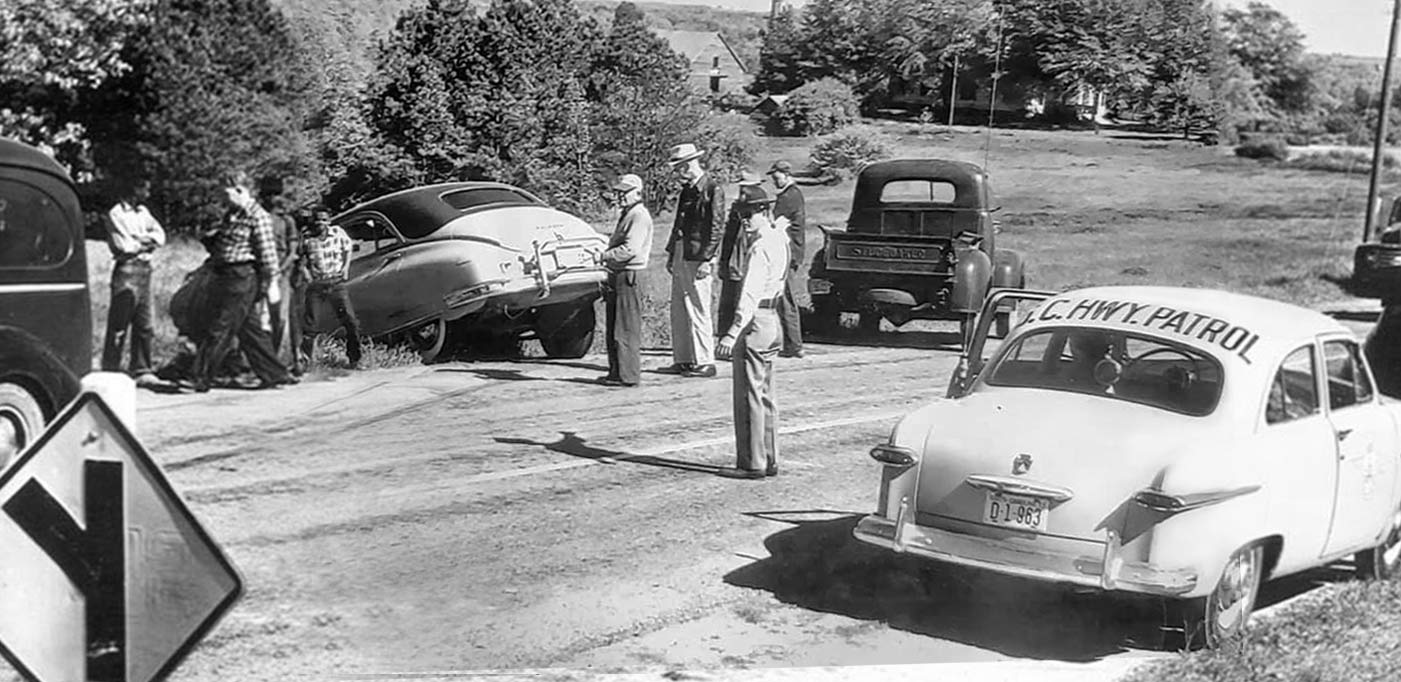
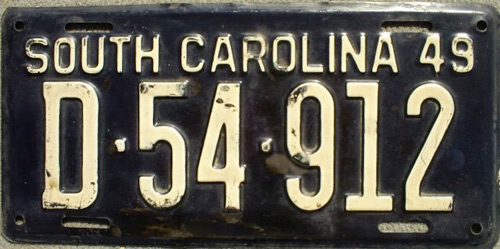 1949-Weight Class D 1949-Weight Class D (3001-3500 lbs) Passenger plates. Approx. 6" x 12 1/2". Embossed steel. White over black. |
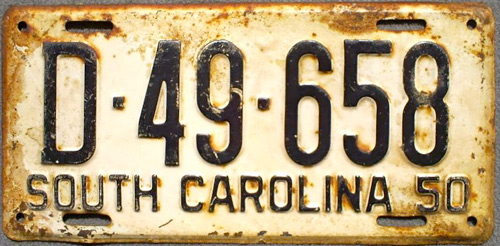 1950-Weight Class D 1950-Weight Class D (3001-3500 lbs) Passenger plates. Approx. 6" x 12 1/2". Embossed steel. Black over white. |
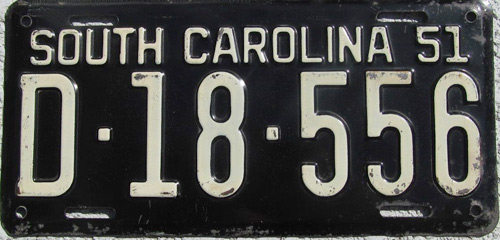 1951-Weight Class D 1951-Weight Class D (3001-3500 lbs) Passenger plates. Approx. 6" x 12 1/2". Embossed steel. White over black. |
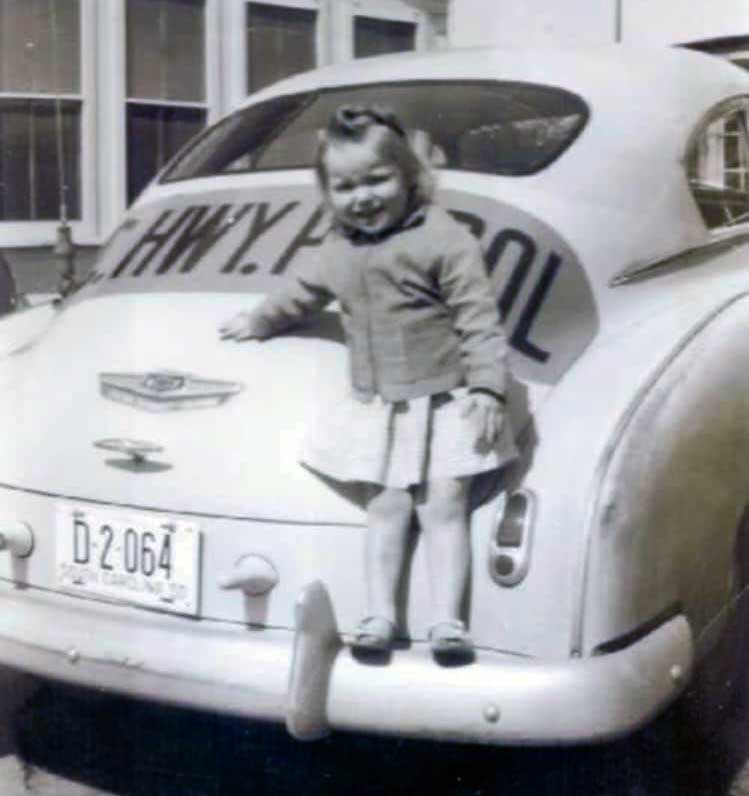 1950 Class D (3001-3500 lbs automobile)
1950 Class D (3001-3500 lbs automobile)
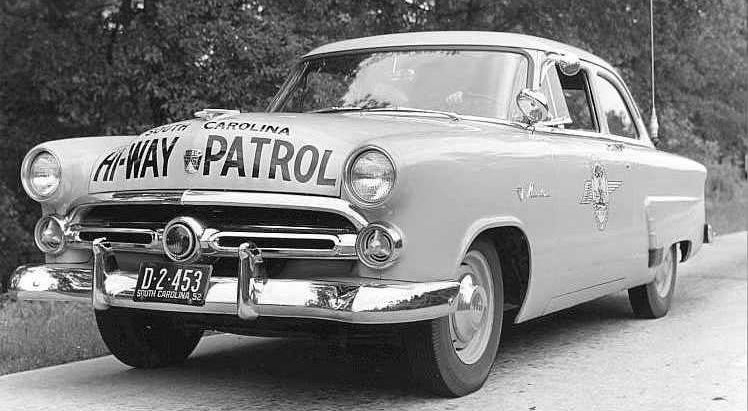
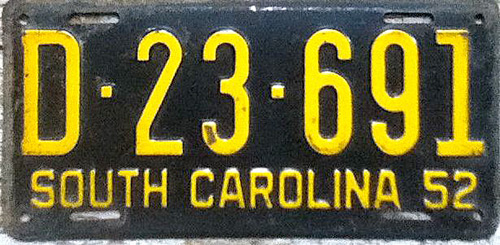 1952-Weight Class D 1952-Weight Class D (3001-3500 lbs) Passenger plates. Approx. 6" x 12 1/2". Embossed steel. Yellow over black |
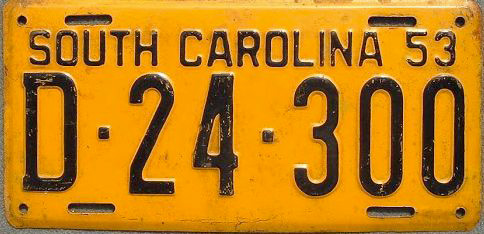 1953-Weight Class D 1953-Weight Class D (3001-3500 lbs) Passenger plates. Approx. 6" x 12 1/2". Embossed steel. Black over deep yellow |
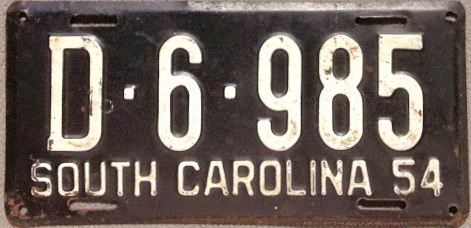 1954-Weight Class D 1954-Weight Class D (3001-3500 lbs) Passenger plates. Approx. 6" x 12 1/2". Embossed steel. White over black |
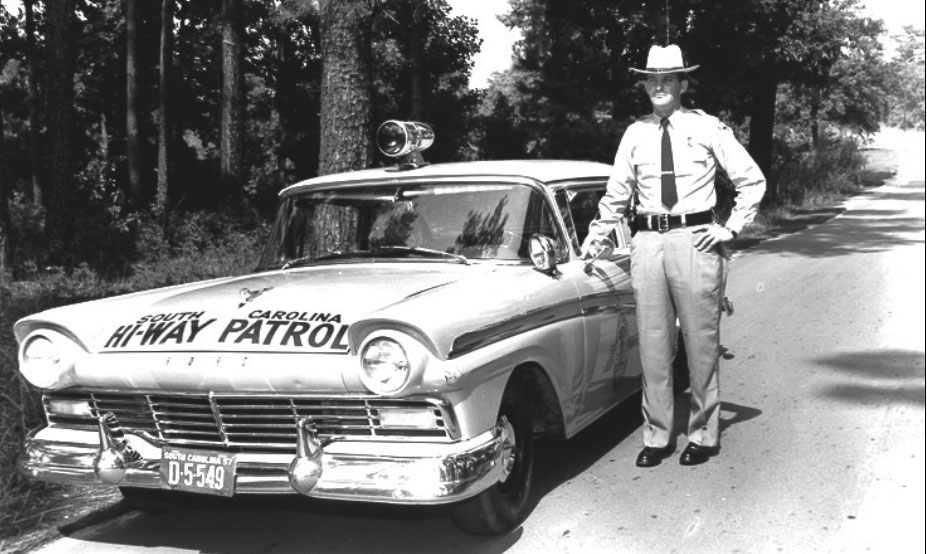
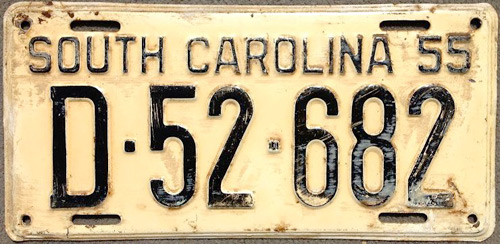 1955-Weight Class D 1955-Weight Class D (3001-3500 lbs) Passenger plates. Embossed steel. Black over white |
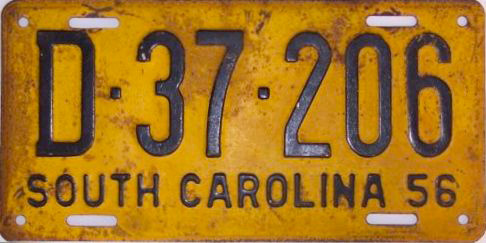 1956-Weight Class D 1956-Weight Class D (3001-3500 lbs) Passenger plates. Embossed steel. Black over deep yellow |
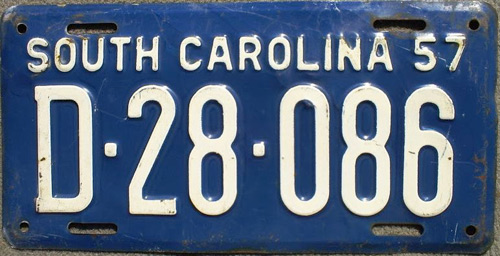 1957- Weight Class D 1957- Weight Class D (3001-3500 lbs) Passenger plates. Embossed steel. White over blue. |
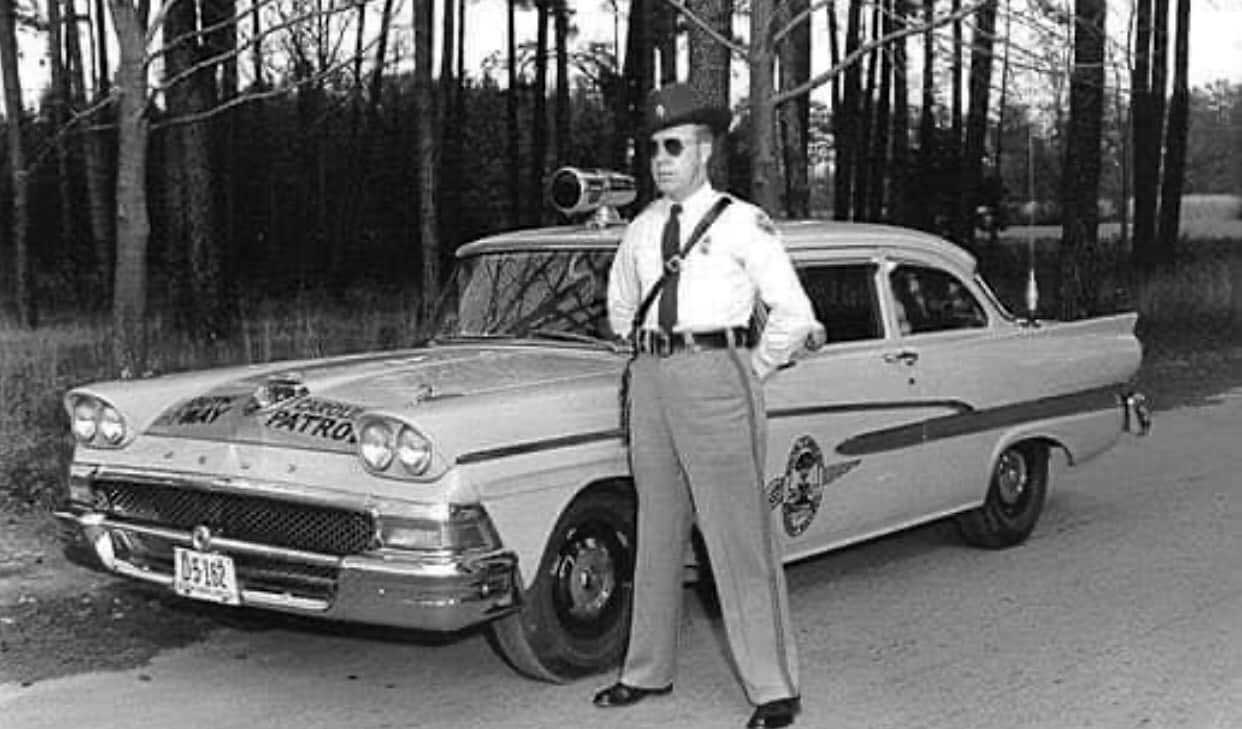 1958. State Patrolman Earl Linder
1958. State Patrolman Earl Linder
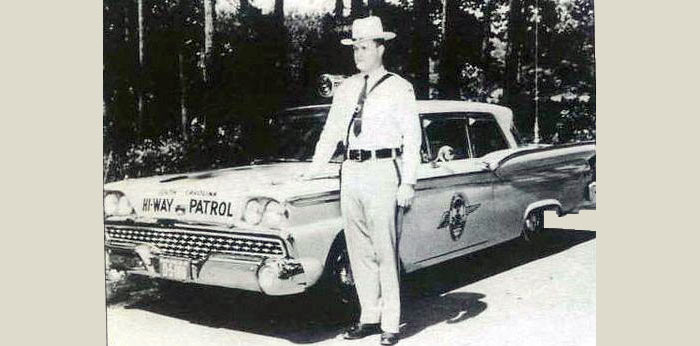
|
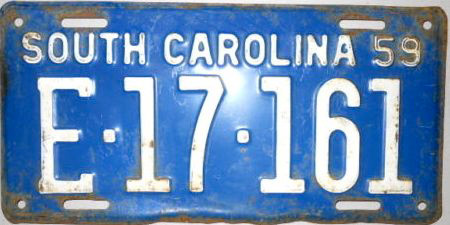 1959- Weight Class E 1959- Weight Class E (3501-4000 lbs) Passenger plates. Embossed steel. White over blue. |
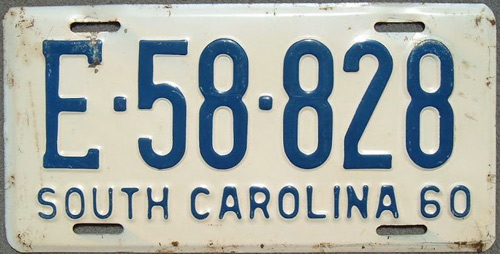 1960- Weight Class E 1960- Weight Class E (3501-4000 lbs) Passenger plates. Embossed steel. Blue over white |
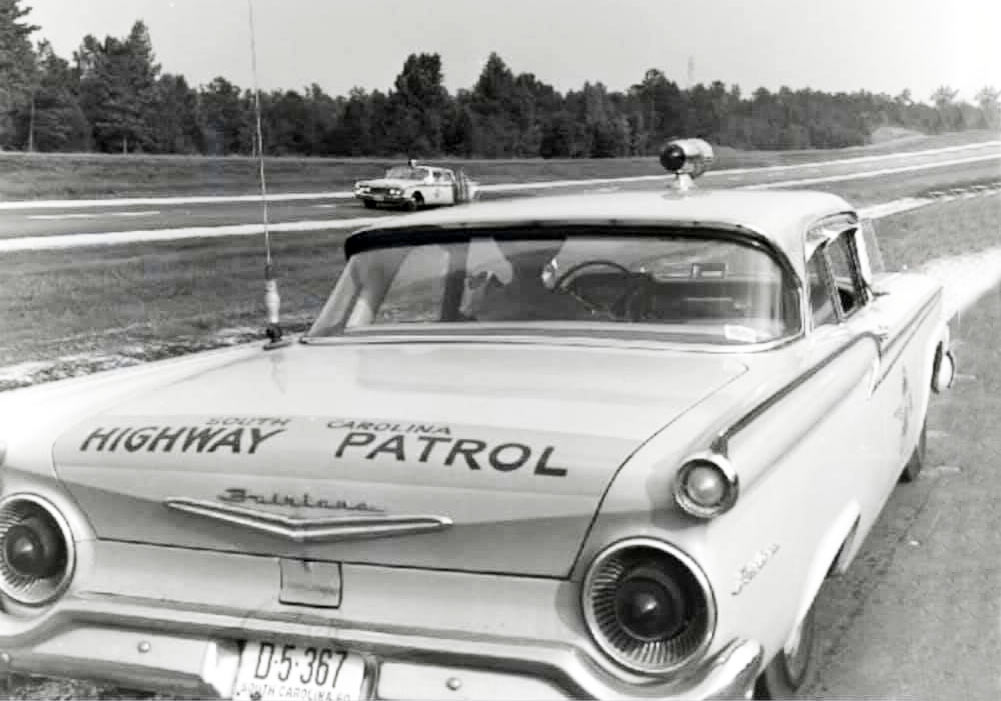 Two Highway patrolmen wave as they pass on the newly opened Interstate 26 in 1960.
Two Highway patrolmen wave as they pass on the newly opened Interstate 26 in 1960. 1961 Weight Class E
1961 Weight Class E 
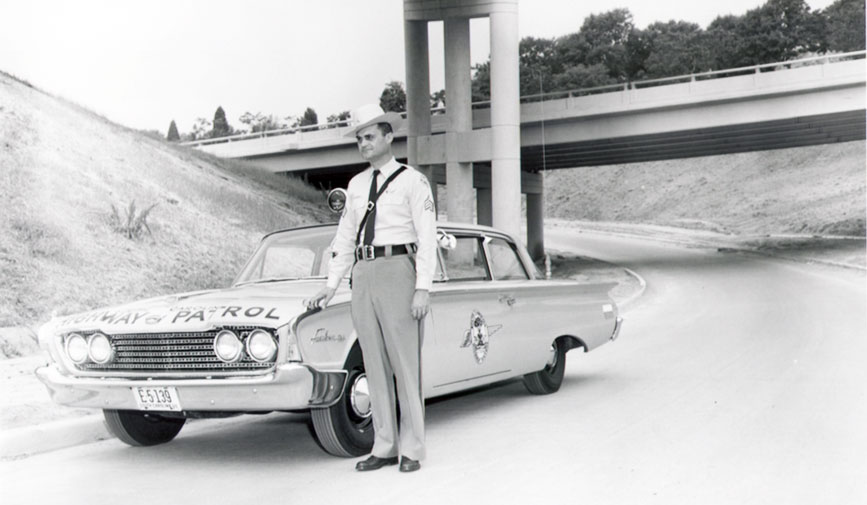
In 1962, the state of South Carolina introduced a series of license plate prefix codes for the various levels of government as it related to official use vehicles. The SG prefix was reserved for any state government vehicles including the Highway Patrol. The plates followed the same format and color scheme of the annual passenger car license plates issued in the state. The SG prefix was followed by a small dash, followed by a number up to four digits in the earlier years.
By the 1980's, the number increased to five digits after the SG prefix.
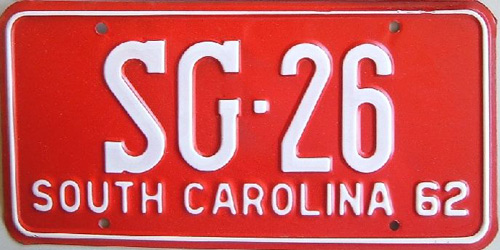 1962 State Government issue.
1962 State Government issue. 
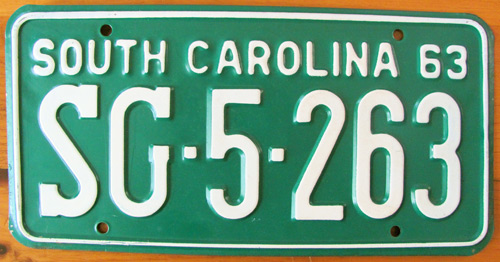 1963 State Government issue.
1963 State Government issue. 
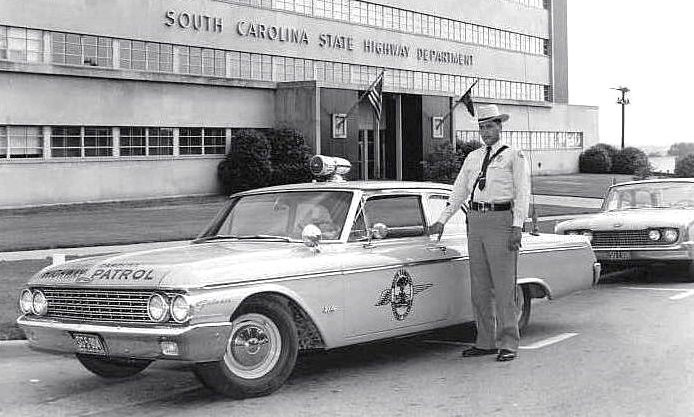
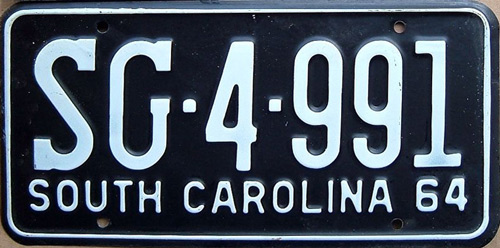 1964 State Government issue.
1964 State Government issue. 
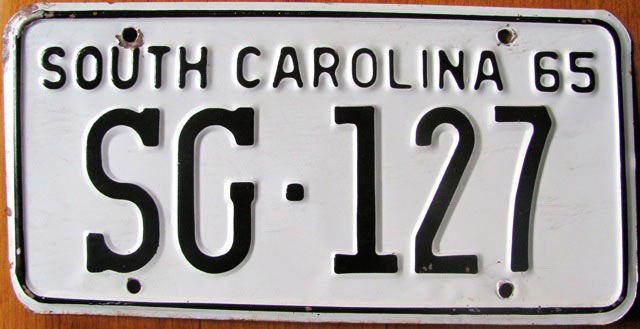 1965 State Government issue.
1965 State Government issue. 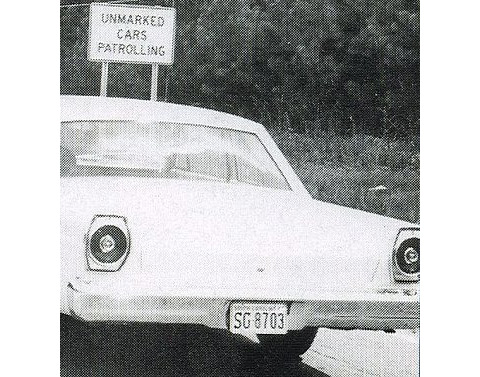
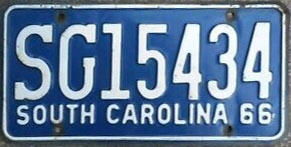 1966 State Government issue.
1966 State Government issue. 
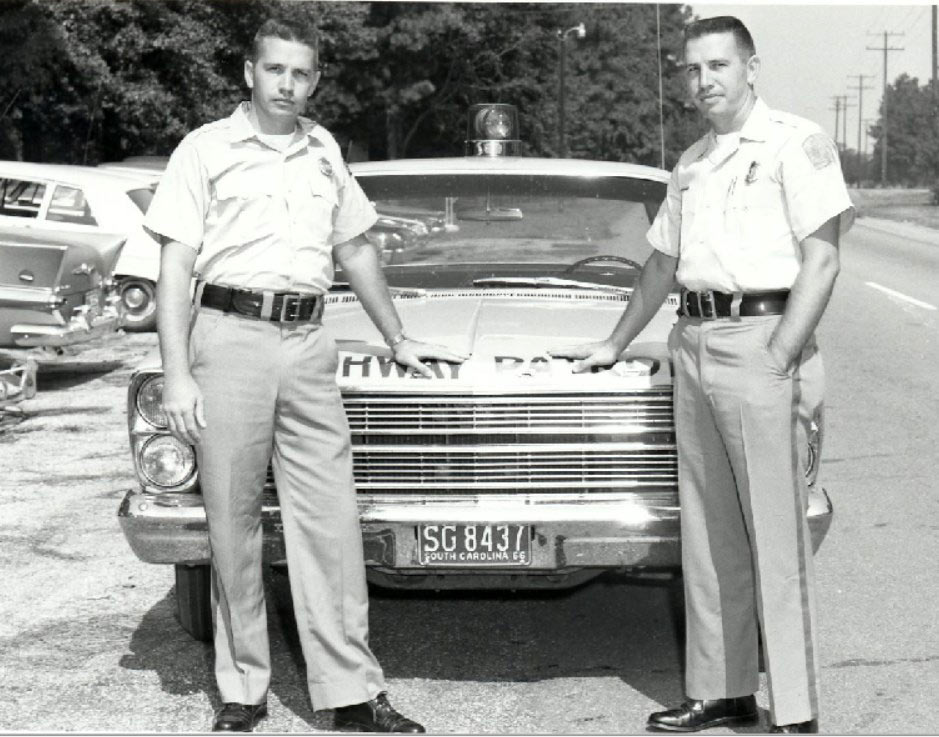 1966 issue in 8400 number bloc.
1966 issue in 8400 number bloc.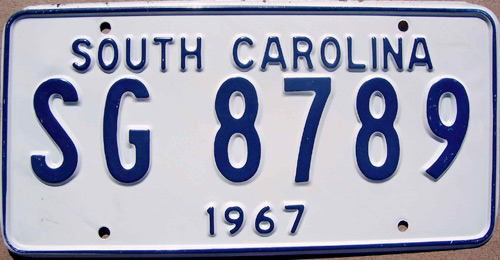 1967 State Government issue.
1967 State Government issue. 
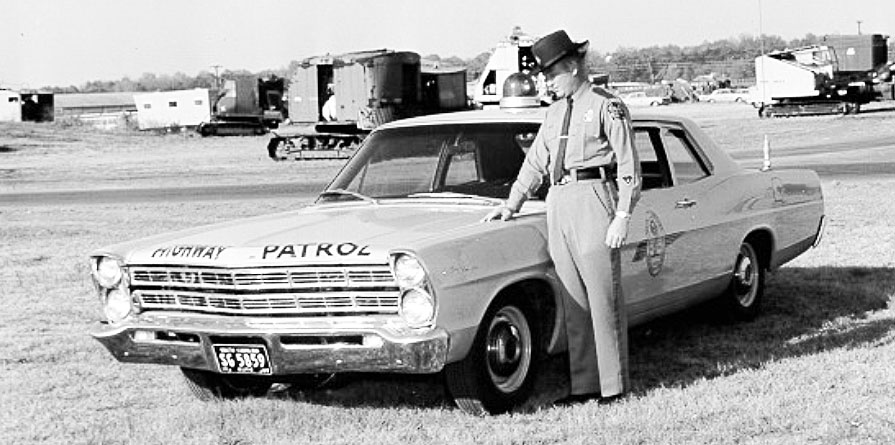
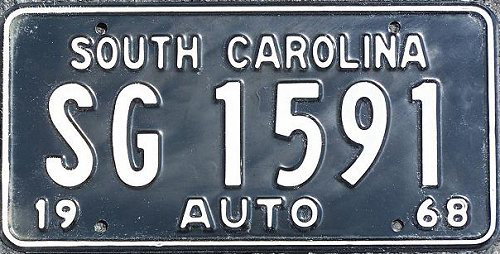 1968 State Government issue.
1968 State Government issue. 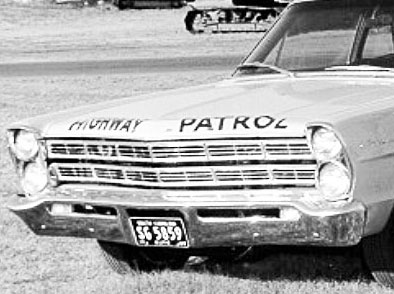
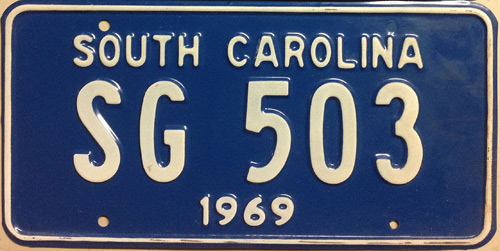 1969 State Government issue.
1969 State Government issue. 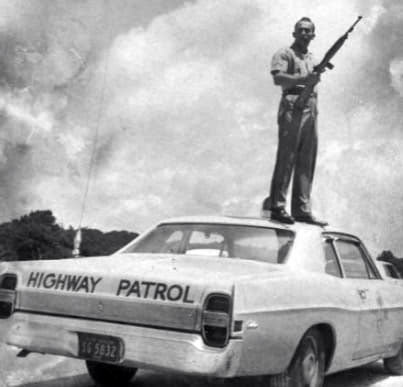 Sammy Martin atop a patrol car in the man hunt for Forrest W. Phillips, who murdered CPL R.V. Woods in August 1969.
Sammy Martin atop a patrol car in the man hunt for Forrest W. Phillips, who murdered CPL R.V. Woods in August 1969.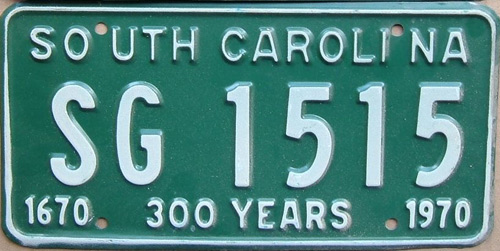 1970 State Government issue.
1970 State Government issue. 
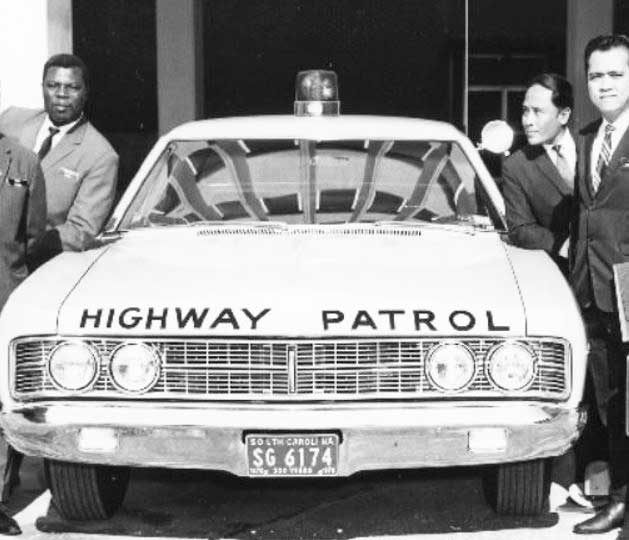 SCHP Headquarters 1970
SCHP Headquarters 1970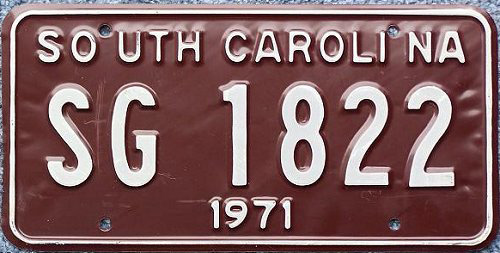 1971 State Government issue.
1971 State Government issue. 
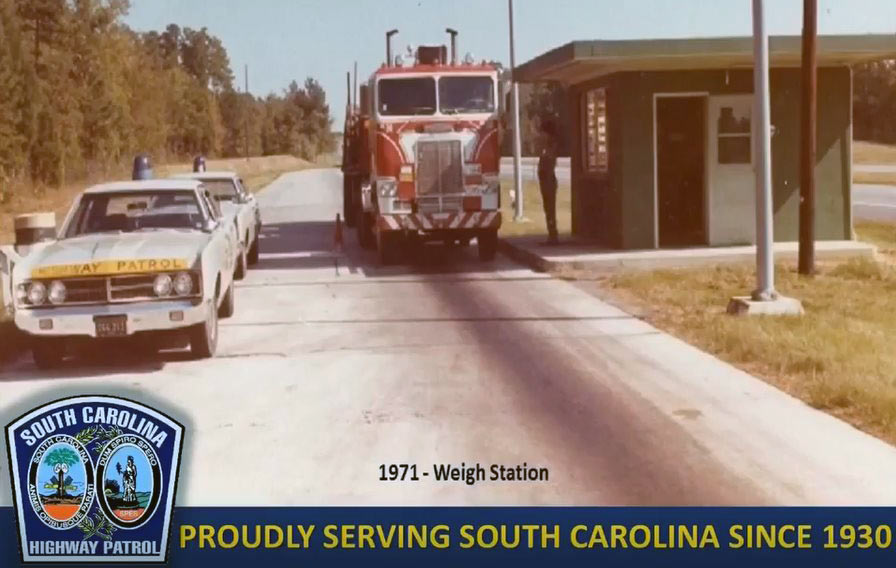 1971 in SGA series
1971 in SGA series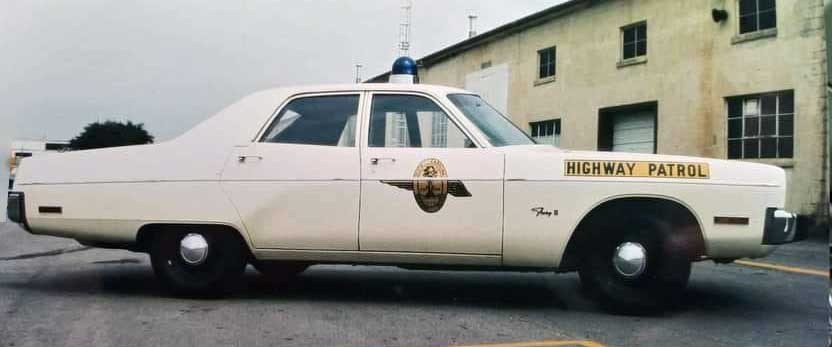 SCHP Plymouth Fury II
SCHP Plymouth Fury II 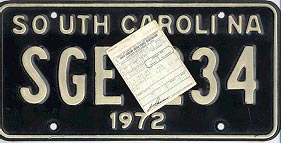 1972 State Government issue.
1972 State Government issue. 
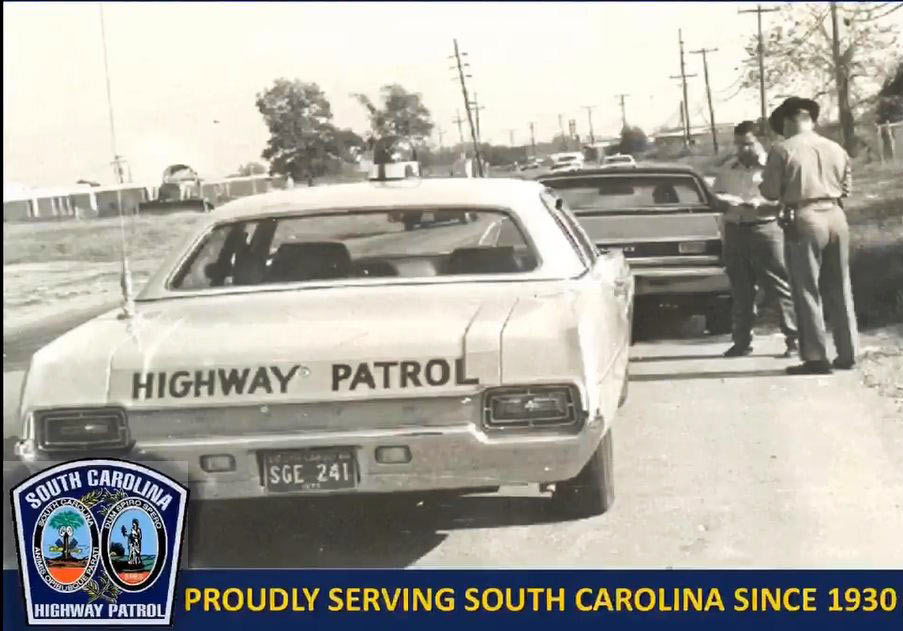 1972 in SGE series.
1972 in SGE series. 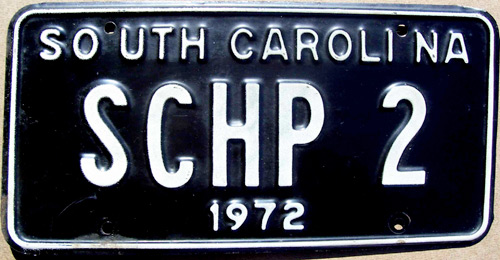 1972 issue for the Lieutenant Colonel of the SCHP
1972 issue for the Lieutenant Colonel of the SCHP
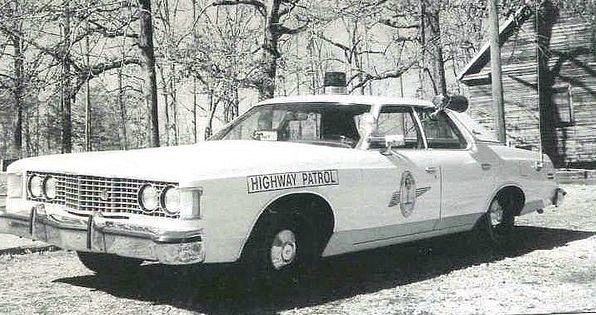
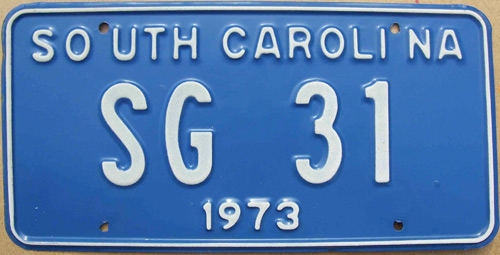 1973 State Government issue.
1973 State Government issue. 
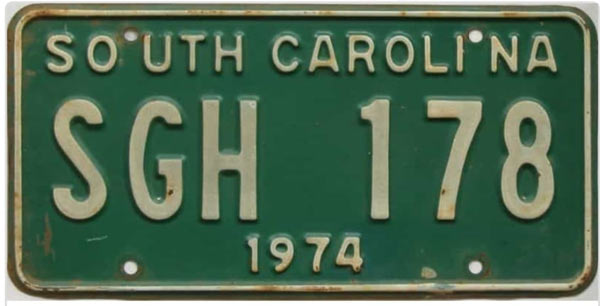 1974 State Government issue.
1974 State Government issue. 
 1974- #SGL 116
1974- #SGL 116 1974 brought about some question as to what type of state government license plates were used on SCHP vehicles. The reason for this uncertainty was due to TWO TYPES of SG license plates introduced that year. The first type was a continuation of the annual plate which was formatted the same as previous annual issues leading up to that time, with SOUTH CAROLINA embossed along the top of the plate and 1974 embossed along the bottom. A registration number commencing with SG and another letter followed by three numbers was in the color scheme of reflective white over green. Confirmed numbers used on this base plate for SCHP are: SGD 200, SGD 227, SGE 151, SGE 158, SGF 114, SGG 125, SGG 142, SGK 125 and SGL 116.
The other state government license plate issued at that time was colored reflective white over black and in lieu of the year at the bottom of the plate, was the word PERMANENT. These plates seem to have been used primarily on trucks and trailers, however there are some old-timers who recall these plates also used on SCHP cars. This type is seen "on duty"on a SLED Bloodhound station wagon seen below.
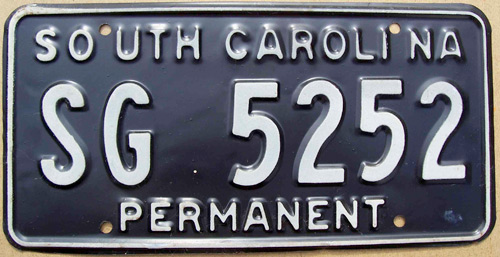 1974-circa 1980 Permanent State Government issue.
1974-circa 1980 Permanent State Government issue.
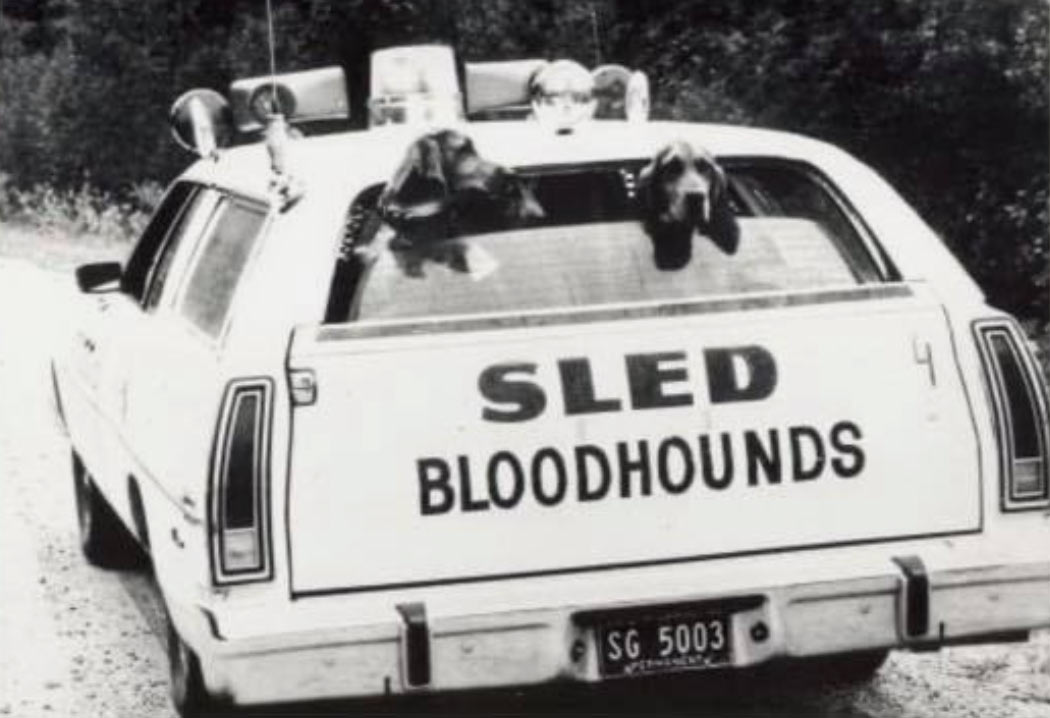 South Carolina Law Enforcement Division Bloodhounds - Circa 1975
South Carolina Law Enforcement Division Bloodhounds - Circa 1975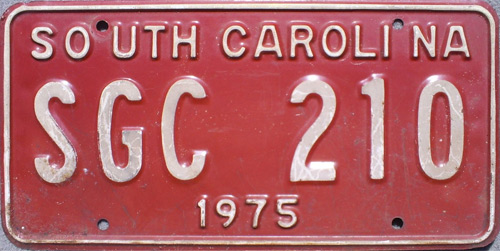 1975 State Government issue.
1975 State Government issue. 
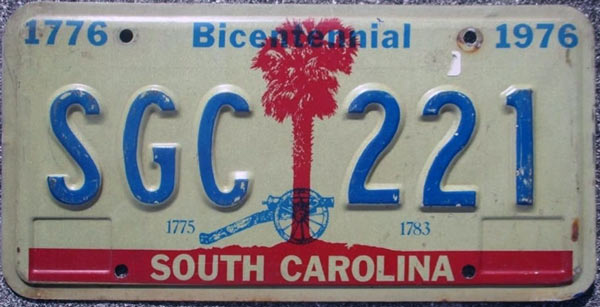 1976-1978 State Government issue. Embossed aluminum.
1976-1978 State Government issue. Embossed aluminum.
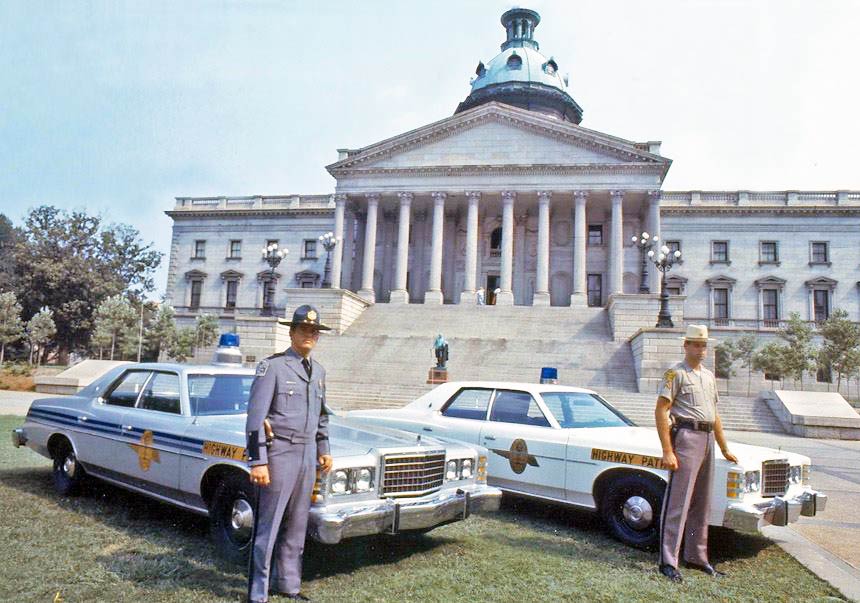 The big change-over in uniform and vehicle livery. 1978
The big change-over in uniform and vehicle livery. 1978 Around late 1979 to early 1980, South Carolina issued an entirely new style license plate for use on state government vehilces including the Highway Patrol. The new plates were made of embossed aluminum and featured a subdued silkscreen graphic of the state silhouette in light blue over a reflective white background. The state emblem was emblazoned in white over the state silhouette. The state name was silkscreened in dark blue at the bottom of the plate between the lower mounting holes. The word PERMANENT was embossed at the top of the plate between the upper mounting holes. The prefix SG was used again with a five digit number of random issue for SCHP use. These plates had an embossed border painted in dark blue as were the raised characters.
These plates were used into the 1990's.
 C.1979-1990's State Government issue.
C.1979-1990's State Government issue. 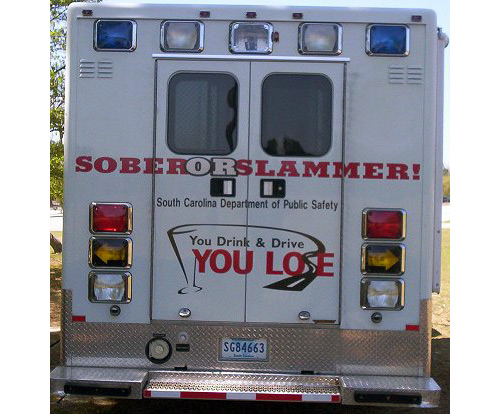
 1981 group.
1981 group. 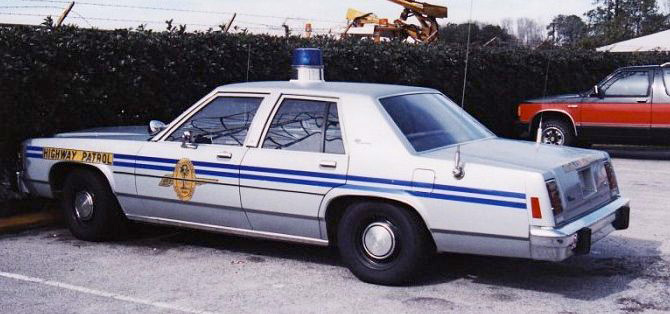
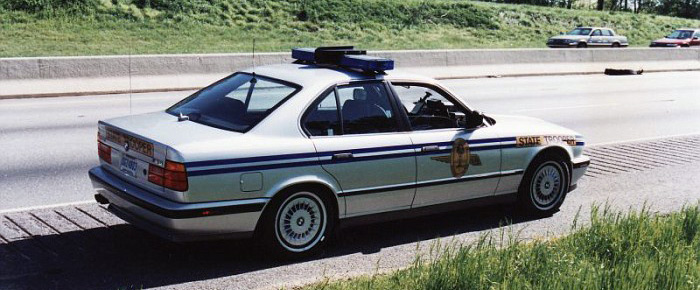
Around late 1984, a slight change was made to the license plates issued for government vehicles in the state of South Carolina. The plates went back to embossed steel and did-away with the silkscreened graphics. The state name was embossed in small die font between the lower mounting holes. Otherwise, the plates continued with their SG prefix and five digit numbers.
 SSP Ford Mustang
SSP Ford Mustang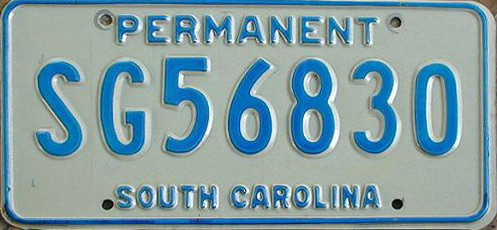 C. 1984-1991 State government issue.
C. 1984-1991 State government issue.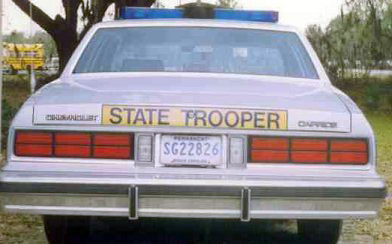
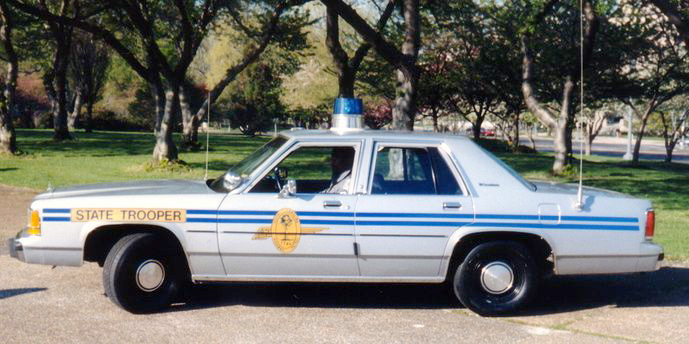
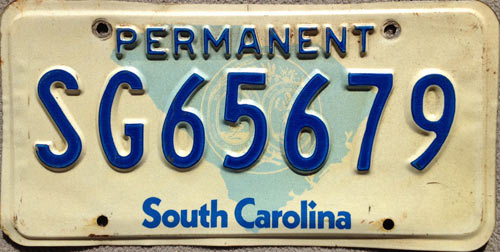 C. 1989-2009 State government issue.
C. 1989-2009 State government issue.
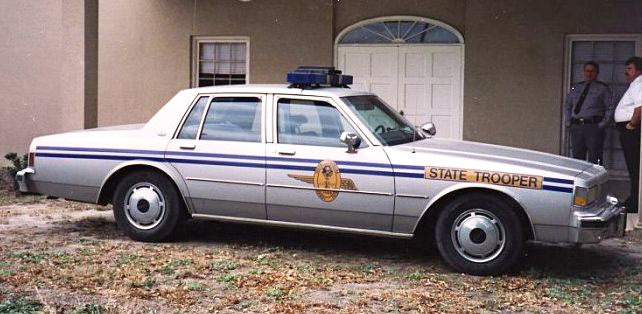
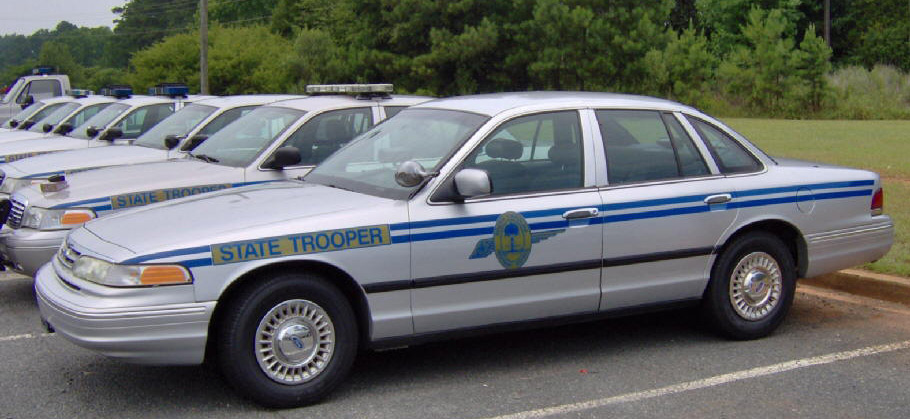
In 1991, the South Carolina Highway Patrol finally were able to get their first reserved issue license plates. The plates were identical to the circa-1979-1990's graphic SG plates, however with the only exception being the HP prefix for Highway Patrol and a four digit number which begins at HP 1000.
The number was initially assigned based on rank seniority, however it seems as though the numbers are issued randomly now.
From 2009 onward, these plates became entirely flat-silkscreened with no embossed features whatsoever.
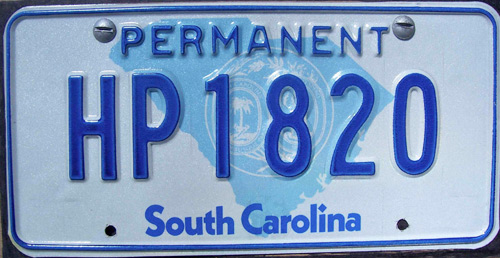 1991-current Highway Patrol issue. Embossed aluminum.
1991-current Highway Patrol issue. Embossed aluminum.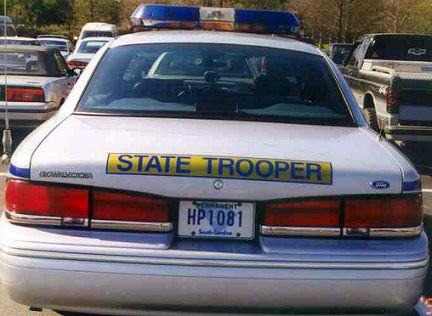
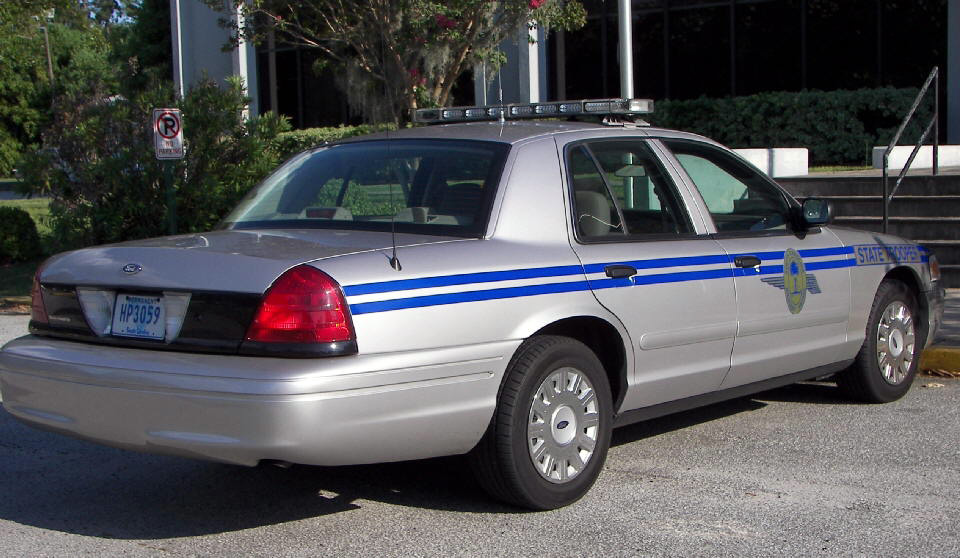
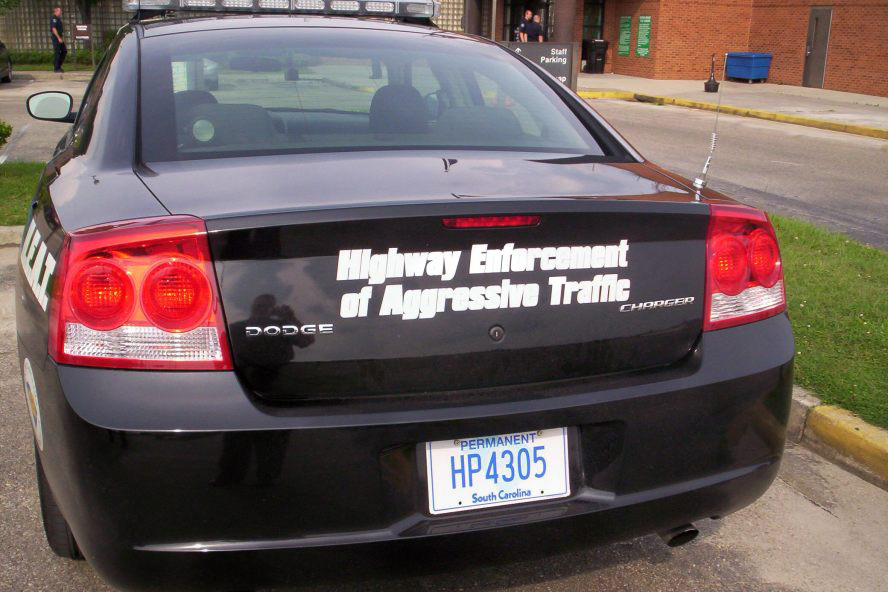
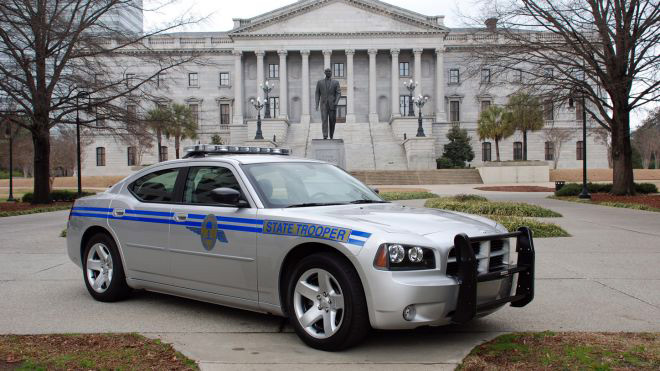
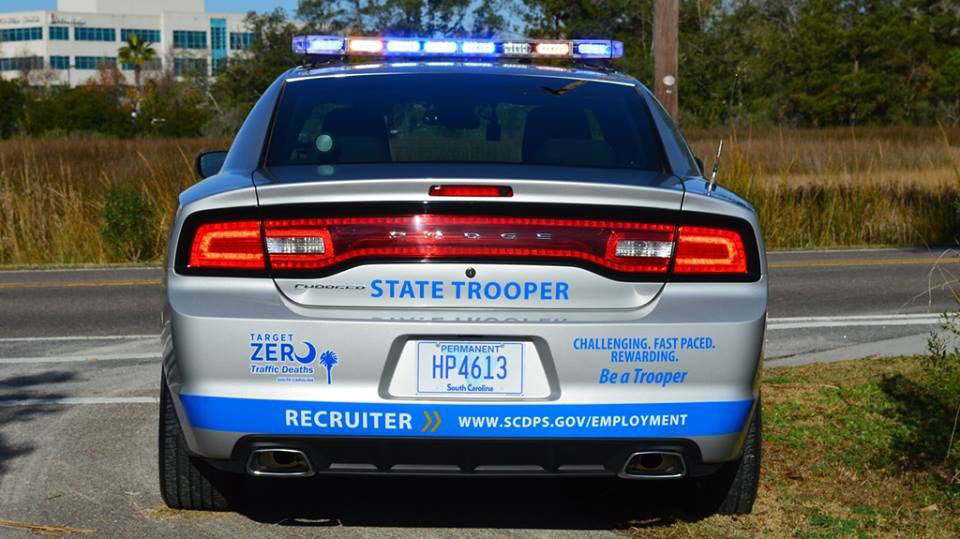 2015
2015 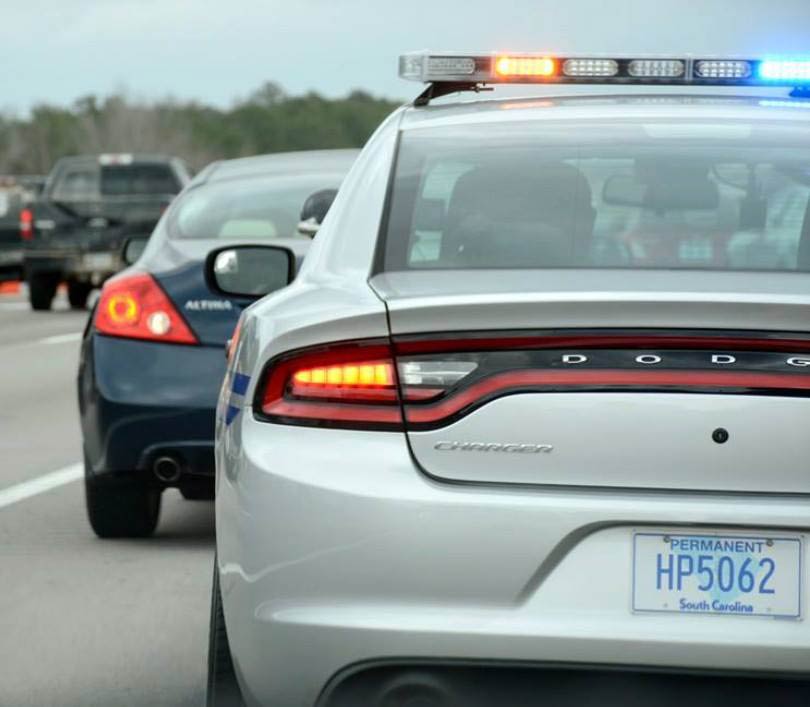
In the Spring of 2018, the South Carolina Highway Patrol received new license plates for the marked fleet. The new plates were once again entirely silkscreened with the only embossing being the step border on the perimeter of the plate. The background of the plate was once again reflective white. PERMANENT was silkscreened in black centered between the two upper mounting holes and flanked with a blue stripe above and a red stripe below spanning the length of the plate.
A silhouette of the state in light blue is situated on the center left portion of the plate with the state seal in white in the center. The center field of the plate is occupied by a stacked HP prefix ahead of a four digit number silkscreened in black.
The state name is silkscreened in black centered between the two lower mounting holes. A small black bar code is situated on the step border to the right of the right lower mounting hole.
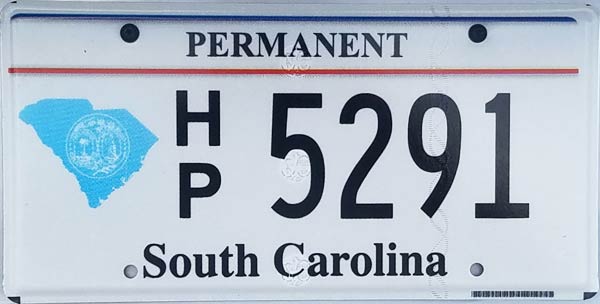 Spring 2018-2019 issue.
Spring 2018-2019 issue.  (Courtesy Ben Bunton)
(Courtesy Ben Bunton)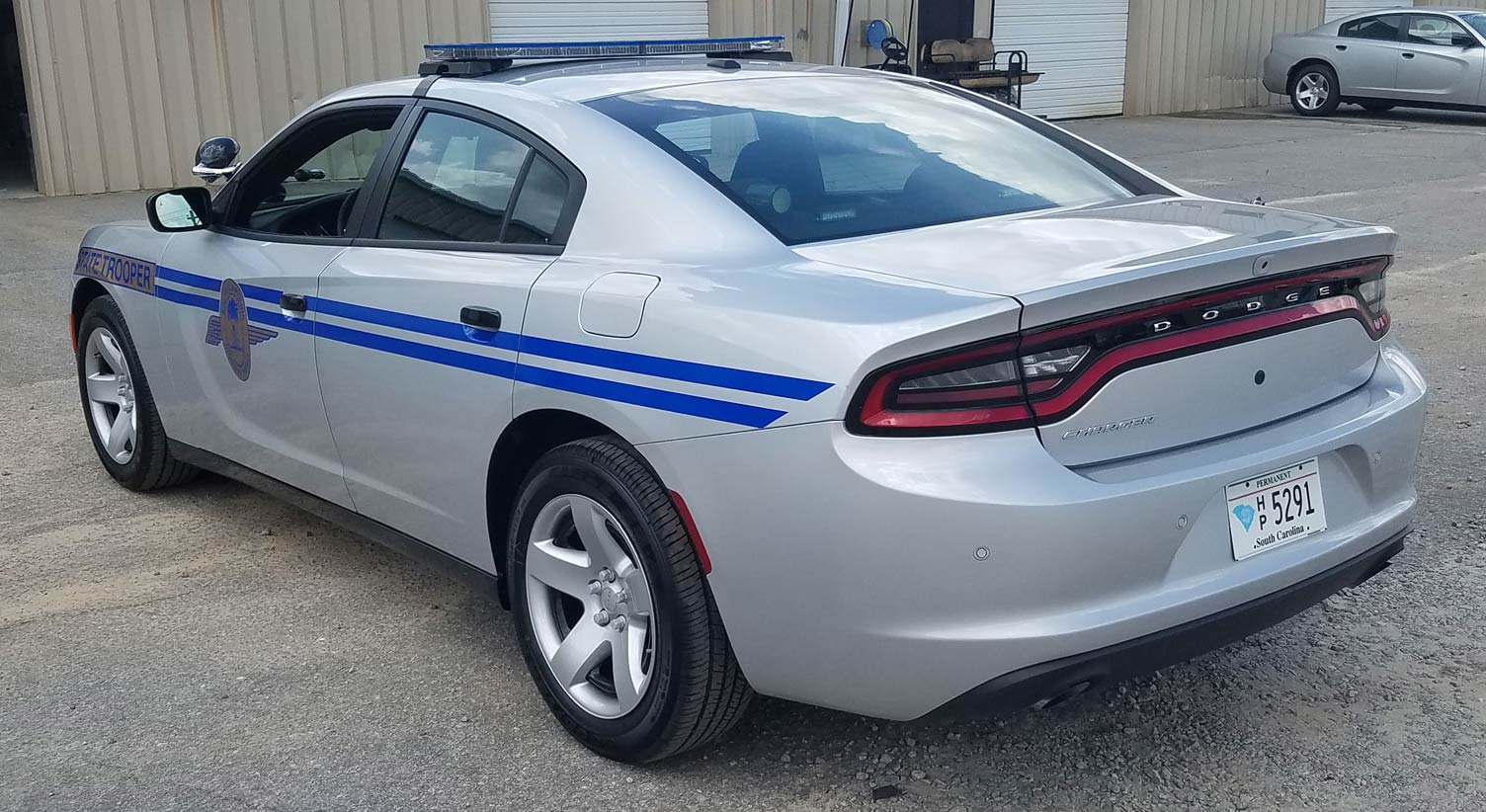 2018
2018 In September 2019, the South Carolina Highway Patrol took their already striking-looking license plate design from the year before and improved it. They replaced the upper title of PERMANENT to Highway Patrol and replaced the pale blue state motif with the door emblem design.
Otherwise, coloring and layout remained the same.
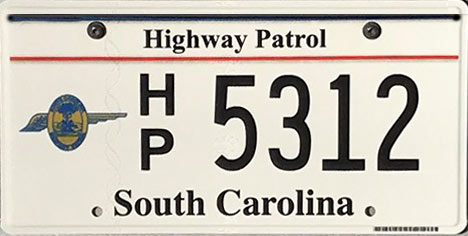 2019-Current issue.
2019-Current issue. 
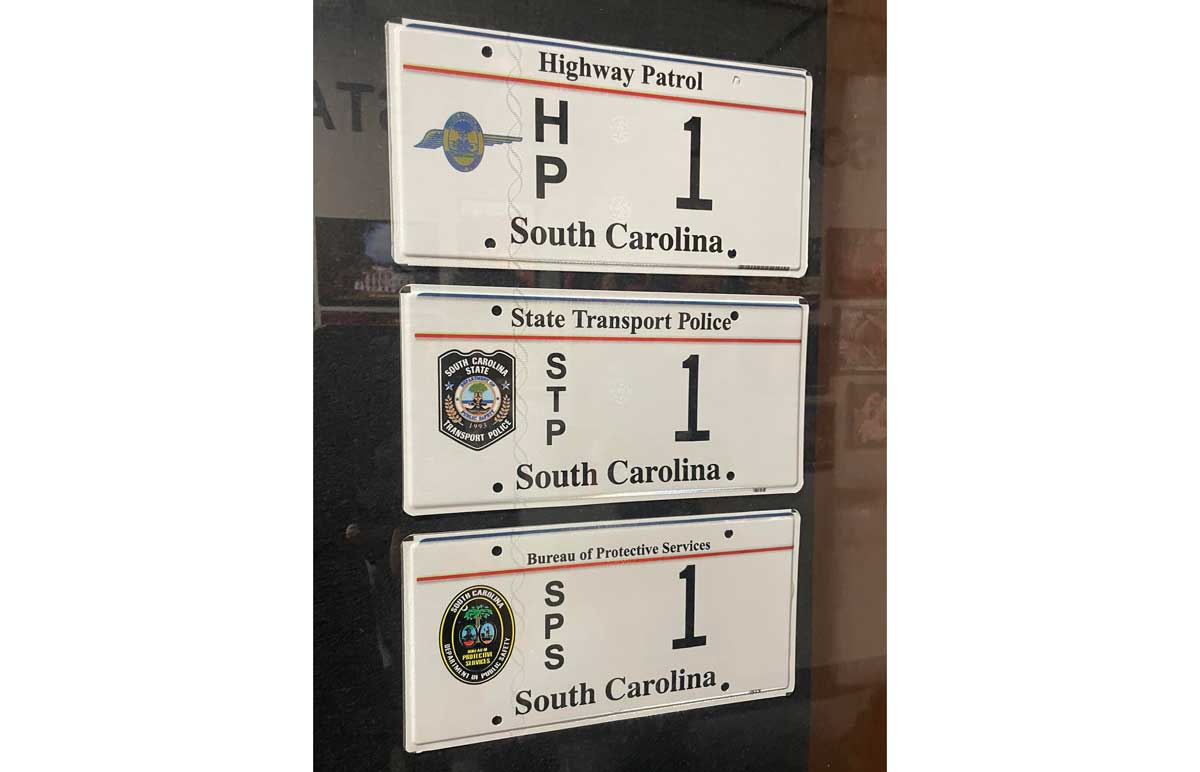 Display of three of the state's top law enforcement agencies: Highway Patrol, State Transport Police and Bureau of Protective Services.
Display of three of the state's top law enforcement agencies: Highway Patrol, State Transport Police and Bureau of Protective Services.Although it is not confirmed when it started, the South Carolina Highway Patrol created an Aggressive Criminal Enforcement (ACE) Team several years ago. According to the 2013 South Carolina Department of Public Safety Manual of Operations for the Highway Patrol Division: The South Carolina Highway Patrol’s Aggressive Criminal Enforcement Team (ACE) as set forth in DPS Policy Directive 300.28 is comprised of four divisions, the Interdiction Unit, the Canine Unit, the Motorcycle Unit and the Department of Transportation Safety Improvement Team. The Interdiction Unit and the Canine Unit are trained in aggressive criminal enforcement methods and the Motorcycle Unit is trained in aggressive traffic enforcement. The Motorcycle Unit is capable of responding to all areas of the state in order to conduct enforcement assignments that include aggressive driving, road rage, and selective enforcement based on prior crash data. The Safety Improvement Team strictly enforces traffic laws around highway construction zone areas. The K-9 Section is responsible for the utilization of the Highway Patrol’s K-9s. The purpose is to detect illegal drug trafficking on the state’s roadways. This Unit is available to assist the Highway Patrol and other law enforcement agencies 24 hours a day.
To qualify as an ACE Team member, a SCHP trooper must have FIVE of the following within one year:
-Drug arrest with a charge of possession with Intent to Distribute/Trafficking,
-Occupied Stolen Vehicle
-US Currency Seizure of $25,000 or more.
-Felon in Possession of a Firearm
-Fugitive from Justice.
Each one earns a 3" red lightning bolt decal with ACE in white.
It was stated that in the Spring of 2018, the ACE Team was disbanded, however there has been no definitive proof that this actually occurred.
 South Carolina Department of Public Safety/SDHP Aggresive Criminal Enforcement front license plate.
South Carolina Department of Public Safety/SDHP Aggresive Criminal Enforcement front license plate.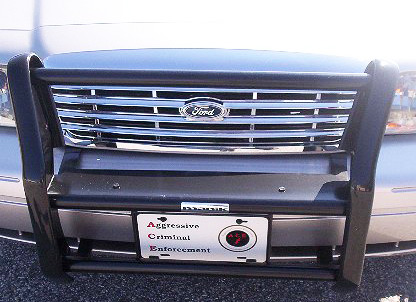
 South Carolina Department of Public Safety/SDHP Aggresive Criminal Enforcement front license plate.
South Carolina Department of Public Safety/SDHP Aggresive Criminal Enforcement front license plate.
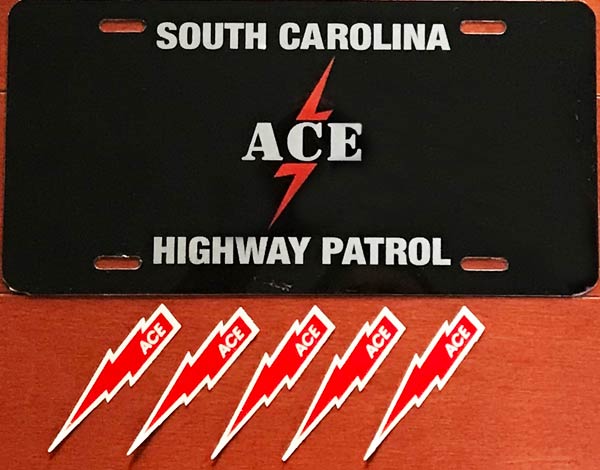 Black version of ACE Team license plate.
Black version of ACE Team license plate.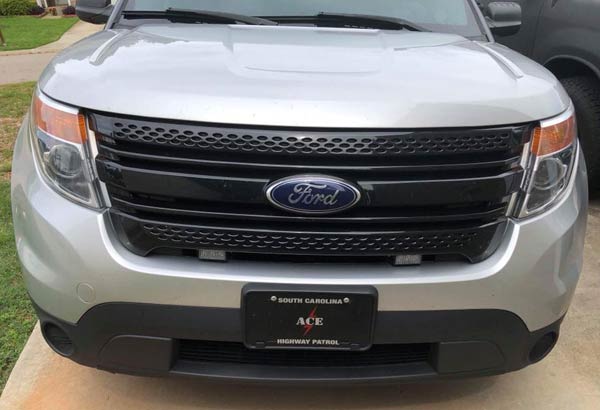
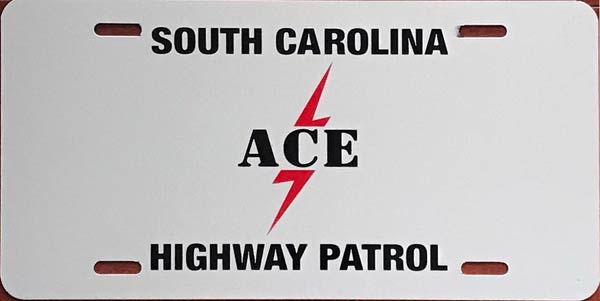 Silver version of ACE Team license plate.
Silver version of ACE Team license plate.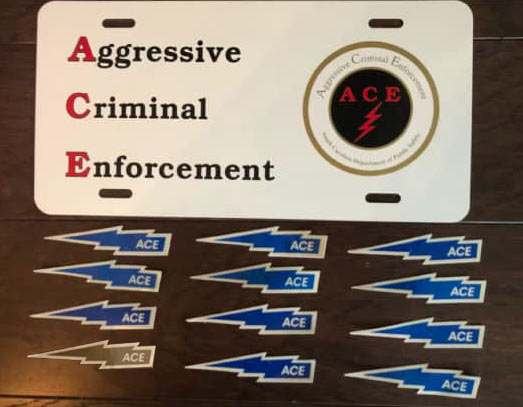 Blue and a gold ACE bolt decals.
Blue and a gold ACE bolt decals.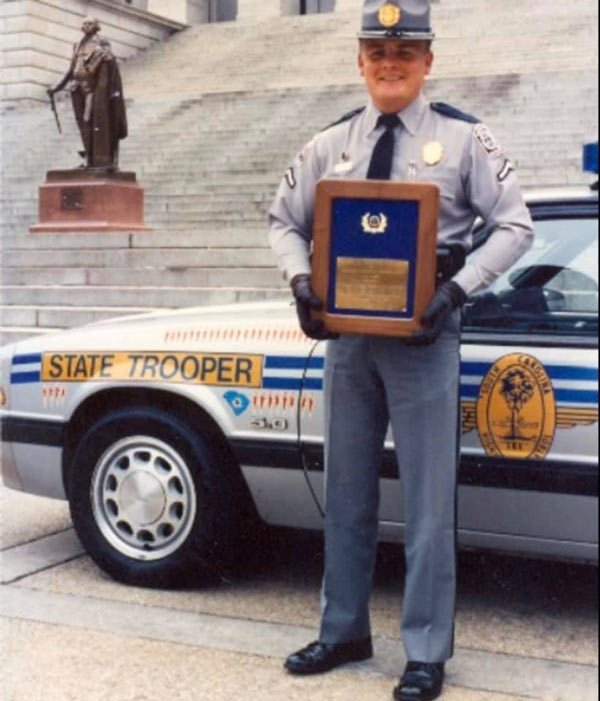 Many ACE bolts earned by this intrepid young trooper affixed to front fender and driver's side door.
Many ACE bolts earned by this intrepid young trooper affixed to front fender and driver's side door.There is very little information known about any motorcycle use by the SCHP prior to the 1990's.
A 1940 photo seen below depicts a SCHP patrolman seated on his motorcycle facing to the rear with a standard South Carolina motorcycle license plate number 180.
Although at first glance, this does not seem remarkable, regular motorcycle license plates issued in SC began with the letter Z (ie: Z180).
Therefore it can be surmised that early SCHP motorcycle license plates were standard civilian issues with no Z prefix in the earlier years.
There is record of embossed steel 9" x 4" South Carolina SG (State Government) prefixed motorcycle plates in existence from 1962 and through 1966 and they utilized the same color scheme as their 6" x 12" contemporaries.
A 1965 version is seen below.
In 1979, a black over reflective white SG-prefixed permanent motorcycle license plate was issued and believed to have been used until the early 1990's.
In the 1990's throughout the 2000's, an HP-prefixed PERMANENT motorcycle license plate was used and colored medium blue over reflective white.
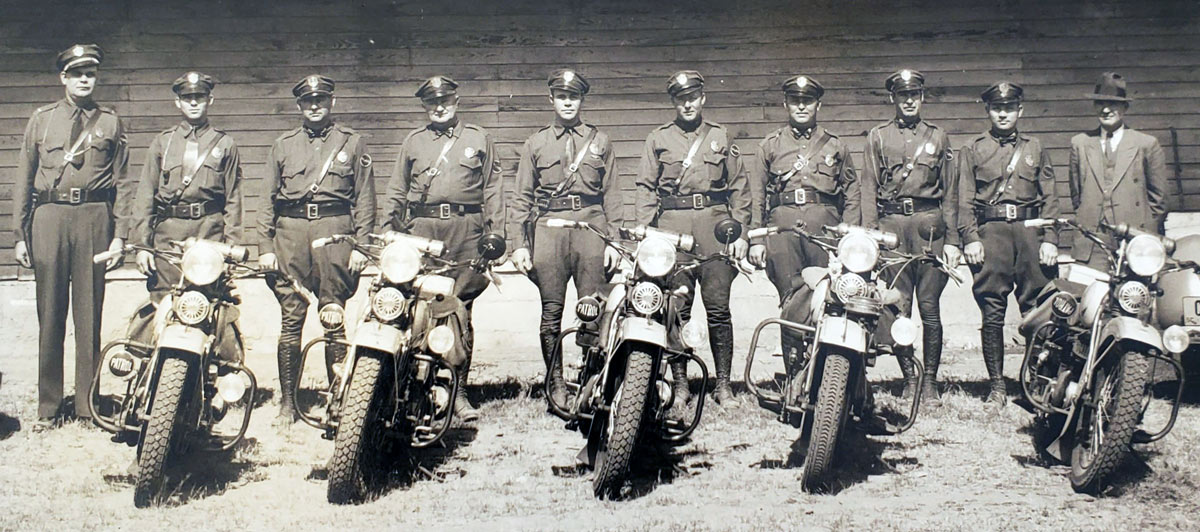
1936
(Courtesy Nick Leary)
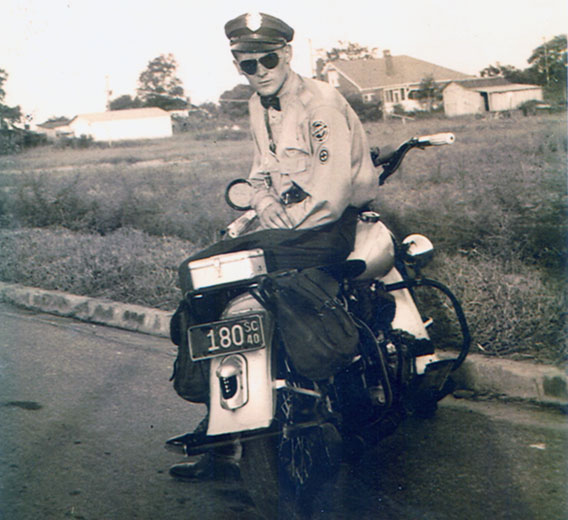
In 1962, the state of South Carolina began issuing State Government motorcycle license plates to be used on the motorcycles of the state Highway Patrol. The plates were made of embossed steel and measured 6 1/4" x 2 1/2" and matched the annual color scheme of regular motorcycle and automobile license plates.
The prefix SG was used followed by a number in the 900 series followed by SC stacked over the last 2 digits of the year.
For 1962 and 1963, the SG prefix was screened and each year thereafter were embossed.
 1962 State Government Motorcycle- First year of issue.
1962 State Government Motorcycle- First year of issue.
 1965 State Government Motorcycle
1965 State Government Motorcycle
 1966 State Government Motorcycle
1966 State Government Motorcycle
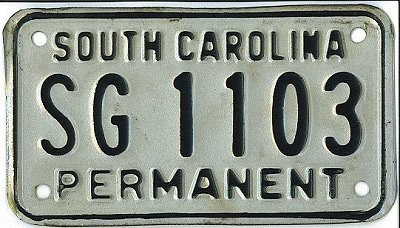 Circa 1979-1990's State government motorcycle issue.
Circa 1979-1990's State government motorcycle issue.
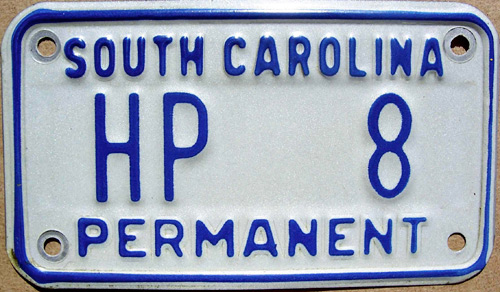 1990's-Current Highway Patrol motorcycle issue.
1990's-Current Highway Patrol motorcycle issue.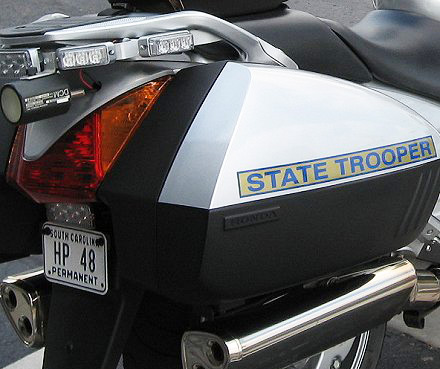
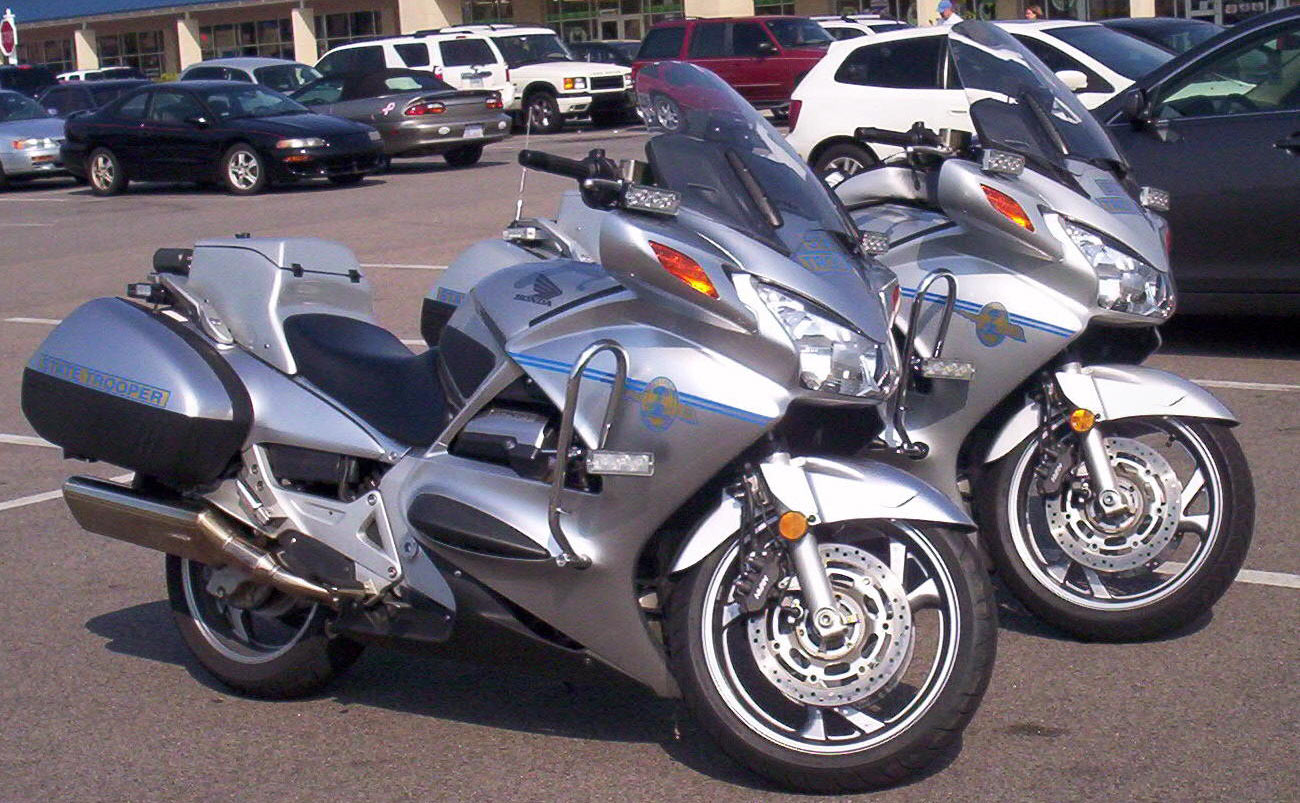
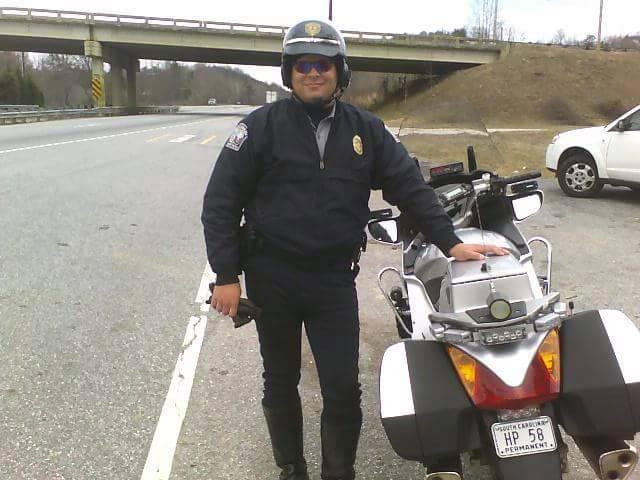
 (Courtesy Benjamin Albright)
(Courtesy Benjamin Albright)
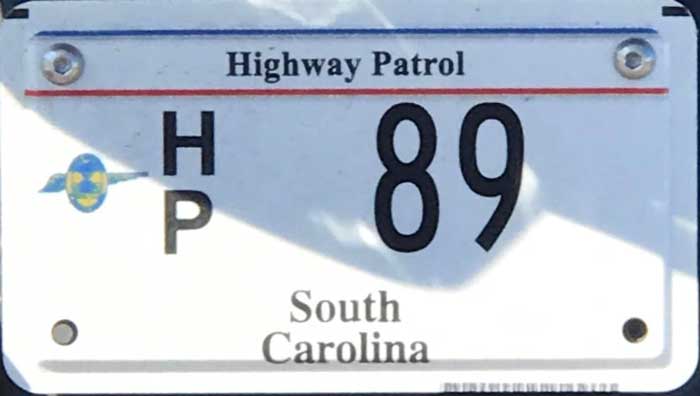 2019-Current motorcycle.
2019-Current motorcycle.
The following are booster and other types used both on and off duty as only rear license plates are mandatory in South Carolina allowing for various types that can be displayed on the front of motor vehicles.
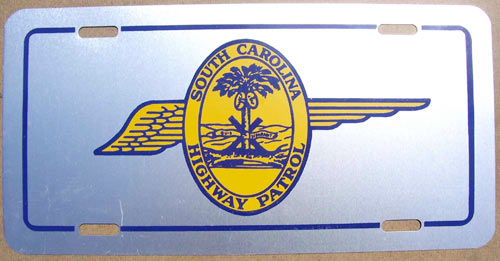 Older all-flat SCHP emblem booster/front license plate.
Older all-flat SCHP emblem booster/front license plate.
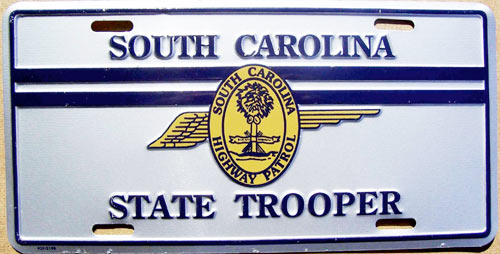 Embossed thin metal front license plate.
Embossed thin metal front license plate.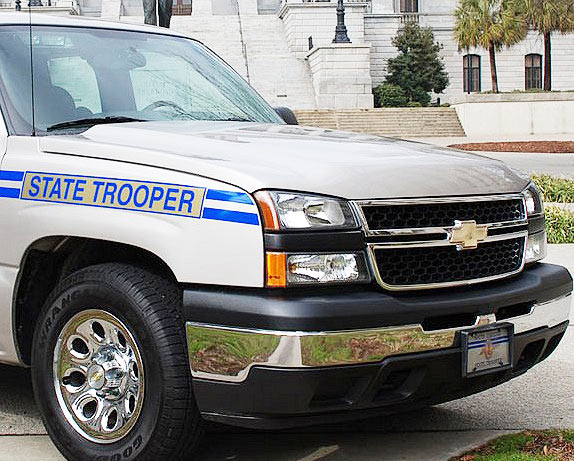
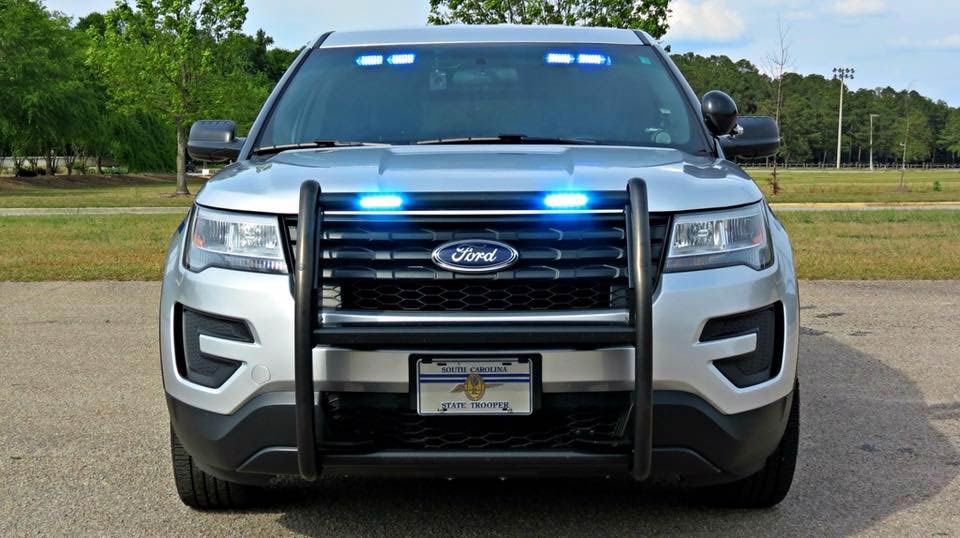
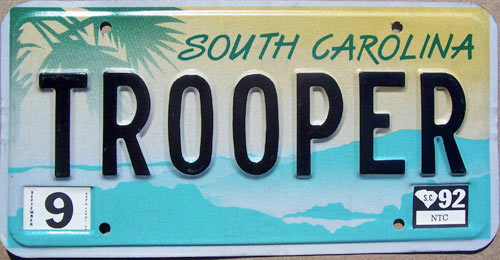 1992 National Troopers Coalition Souvenir issue.
1992 National Troopers Coalition Souvenir issue.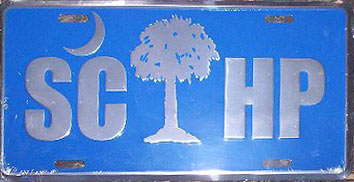 Embossed thin metal front license plate with palmetto.
Embossed thin metal front license plate with palmetto.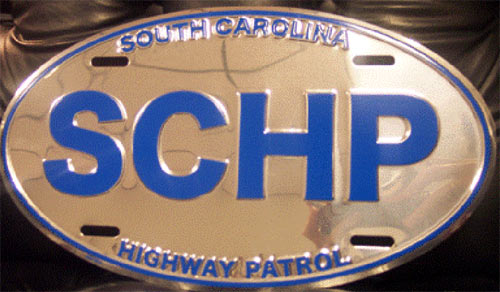 Embossed thin metal oval license plate
Embossed thin metal oval license plate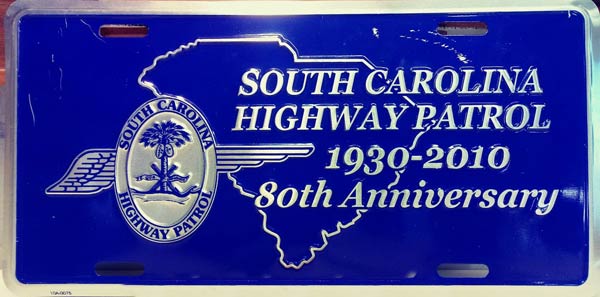 SCHP 80th Anniversary Souvenir.
SCHP 80th Anniversary Souvenir.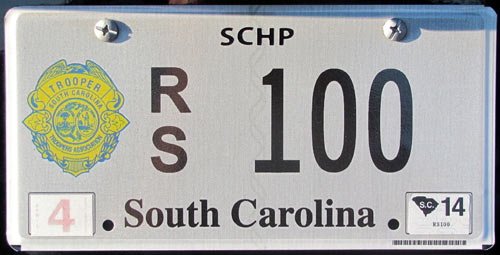 2014-current issue South Carolina Troopers Association.
2014-current issue South Carolina Troopers Association.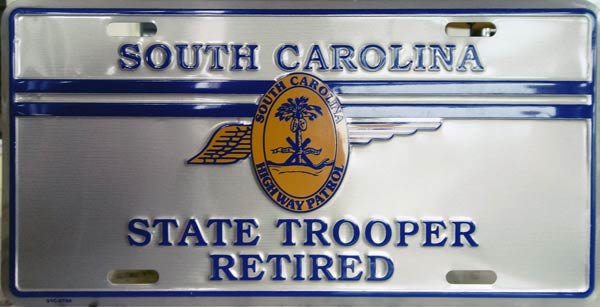 Embossed thin aluminum.
Embossed thin aluminum.